Influences of Gap Flow on Air Resistance Acting on a Large Container Ship
Abstract
1. Introduction
2. Numerical Method
2.1. CAD Modeling
2.2. Computational Fluid Dynamics (CFD)
2.2.1. Computational Domain
2.2.2. Coordinate System and Coefficients
2.2.3. Mesh Generation
2.2.4. Solution Setup
3. Results and Discussions
3.1. CFD Validation
3.2. Gap Flow Effects
3.2.1. Flow in the Gaps between Deck Container Blocks
3.2.2. Gap Air Flow at the Engine Casing
3.2.3. Gap Flow at the Accommodation House
3.3. Shutdown of Gap Flow with Side Cover
3.3.1. Pressure and Velocity Distribution at = 30 deg
3.3.2. Air Resistance Coefficient
4. Conclusions
Author Contributions
Funding
Institutional Review Board Statement
Informed Consent Statement
Data Availability Statement
Acknowledgments
Conflicts of Interest
References
- Koričan, M.; Perčić, M.; Vladimir, N.; Alujević, N.; Fan, A. Alternative Power Options for Improvement of the Environmental Friendliness of Fishing Trawlers. J. Mar. Sci. Eng. 2022, 10, 1882. [Google Scholar] [CrossRef]
- Pérez-Arribas, F.; Silva-Campillo, A.; Díaz-Ojeda, H.R. Design of Dihedral Bows: A New Type of Developable Added Bulbous Bows—Experimental Results. J. Mar. Sci. Eng. 2022, 10, 1691. [Google Scholar] [CrossRef]
- Riesner, M.; El Moctar, O.; Schellin, T. Design related speed loss and fuel consumption of ships in seaways. In Progress in Maritime Technology and Engineering; CRC Press: Boca Raton, FL, USA, 2018; pp. 147–155. [Google Scholar]
- Bialystocki, N.; Konovessis, D. On the estimation of ship’s fuel consumption and speed curve: A statistical approach. J. Ocean. Eng. Sci. 2016, 1, 157–166. [Google Scholar] [CrossRef]
- Zhou, T.; Hu, Q.; Hu, Z.; Zhen, R. An adaptive hyper parameter tuning model for ship fuel consumption prediction under complex maritime environments. J. Ocean Eng. Sci. 2022, 7, 255–263. [Google Scholar] [CrossRef]
- Luo, S.; Ma, N.; Hirakawa, Y. Evaluation of resistance increase and speed loss of a ship in wind and waves. J. Ocean Eng. Sci. 2016, 1, 212–218. [Google Scholar] [CrossRef]
- Vitali, N.; Prpić-Oršić, J.; Soares, C.G. Coupling voyage and weather data to estimate speed loss of container ships in realistic conditions. Ocean Eng. 2020, 210, 106758. [Google Scholar] [CrossRef]
- Haddara, M.R.; Soares, C.G. Wind loads on marine structures. Mar. Struct. 1999, 12, 199–209. [Google Scholar] [CrossRef]
- Fujiwara, T.; Tsukada, Y.; Kitamura, F.; Sawada, H.; Ohmatsu, S. Experimental Investigation and Estimation on Wind Forces for a Container Ship. Proc. Ninet. Int. Offshore Polar Eng. Conf. 2009, 1, 555–562. [Google Scholar]
- Szelangiewicz, T.; Wiśniewski, B.; Želazny, K. The Influence of Wind, Wave and Loading Condition on Total Resistance and Speed of the Vessel. Pol. Marit. Res. 2014, 21, 61–67. [Google Scholar] [CrossRef]
- Sugata, K.; Iwamoto, Y.; Ikeda, Y.; Nihei, Y. Reduction of Wind Force acting on Ships. Proc. APHydro2010 2010, 9480, 5–8. [Google Scholar]
- Andersen, P.; Borrod, A.-S.; Blanchot, H. Evaluation of the Service Performance of Ships. Mar. Technol. SNAME News 2005, 42, 177–183. [Google Scholar] [CrossRef]
- Karabulut, U.C.; Özdemir, Y.H.; Barlas, B. Numerical Investigation of the Effect of Surface Roughness on the Viscous Resistance Components of Surface Ships. J. Marine. Sci. Appl. 2022, 21, 71–82. [Google Scholar] [CrossRef]
- Andersen, I.M.V. Wind loads on post-panamax container ship. Ocean Eng. 2013, 58, 115–134. [Google Scholar] [CrossRef]
- Ouchi, K.; Tanaka, Y.; Taniguchi, A.; Takashina, J.; Matsubara, N.; Kimura, K. A study on air drag reduction on the large container ship in the sea. In Proceedings of the International Conference Design & Operation of Container Ships, London, UK, 21–22 May 2014; pp. 107–114. [Google Scholar]
- Kim, Y.; Kim, K.; Jeong, S.; Jeong, S.; Van, S.; Kim, Y.-C.; Kim, J. Design and Performance Evaluation of Superstructure Modification for Air Drag Reduction of a Container Ship. In Proceedings of the 25th International Ocean and Polar Engineering Conference (ISOPE), Big Island, HI, USA, 21 June–26 June 2020; pp. 894–901. [Google Scholar]
- Van He, N.; Mizutani, K.; Ikeda, Y. Reducing air resistance acting on a ship by using interaction effects between the hull and accommodation. Ocean Eng. 2016, 111, 414–423. [Google Scholar] [CrossRef]
- Van He, N.; Hien, N.; Truong, V.-T.; Bui, N.-T. Interaction Effect between Hull and Accommodation on Wind Drag Acting on a Container Ship. J. Mar. Sci. Eng. 2020, 8, 930. [Google Scholar] [CrossRef]
- Watanabe, I.; Nguyen, V.T.; Miyake, S.; Shimizu, N.; Ikeda, Y. A Study on Reduction of Air Resistance acting on a Large Container Ship. In Proceedings of the APHydro2016, Hanoi, Vietnam, 20–23 September 2016; pp. 321–330. [Google Scholar]
- Nguyen, V.T.; Kinugawa, A.; Shimizu, N.; Ikeda, Y. Studies on Air Resistance Reduction Methods for a Large Container Ship (Part 1). In Proceedings of the JASNAOE Annual Autumn Meeting, Okayama City, Japan, 21–22 November 2016; pp. 427–432. [Google Scholar]
- Blocken, B.; Stathopoulos, T.; van Beeck, J. Pedestrian-level wind conditions around buildings: Review of wind-tunnel and CFD techniques and their accuracy for wind comfort assessment. Build. Environ. 2016, 100, 50–81. [Google Scholar] [CrossRef]
- ITTC. Practical Guidelines for Ship CFD Application. In Proceedings of the 26th International Towing Tanks Conference, Rio de Janeiro, Brazil, 28 August–3 September 2011; Number 7.5-03-02-03; ITTC: 2011. Available online: https://ittc.info/media/1357/75-03-02-03.pdf (accessed on 20 December 2022).
- Van Nguyen, T.; Kinugawa, A. Development of Practical Gap Covers to Reduce Air Resistance Acting on Deck Containers of a Ship. In Proceedings of the 23th conference Japan Society of Naval Architects and Ocean Engineers, Hiroshima, Japan, 27–28 November 2017; pp. 211–216. [Google Scholar]
- Van Nguyen, T. Vortex Control in Gap Flow by Small Appendages to Reduce Air Resistance Acting on Deck Containers of a Ship. In Proceedings of the 24th Conference Japan Society of Naval Architects and Ocean Engineers, Tokyo, Japan, 26 May 2017; pp. 335–338. [Google Scholar]
- Pena, B.; Huang, L. A review on the turbulence modelling strategy for ship hydrodynamic simulations. Ocean Eng. 2021, 241, 110082. [Google Scholar] [CrossRef]

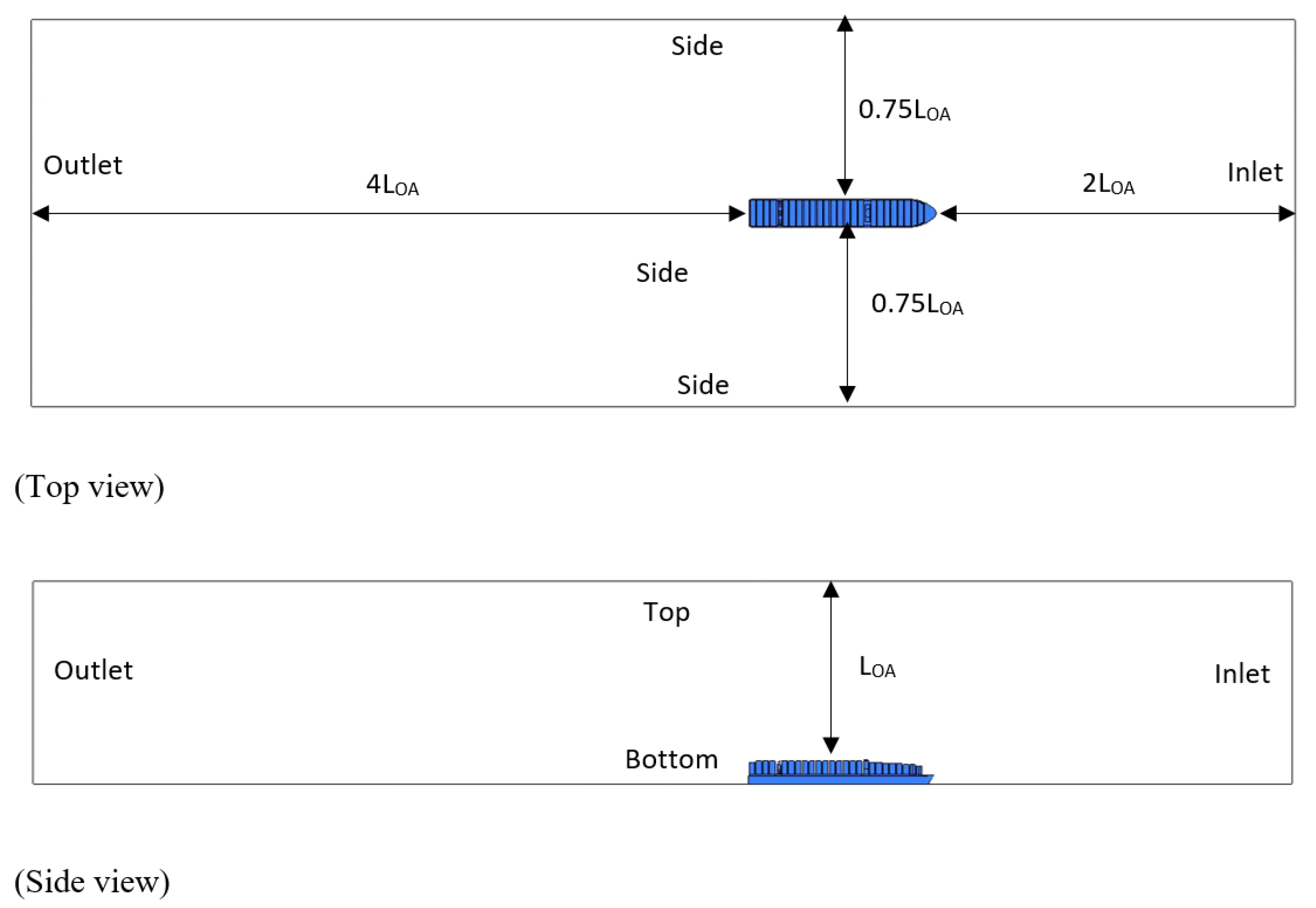
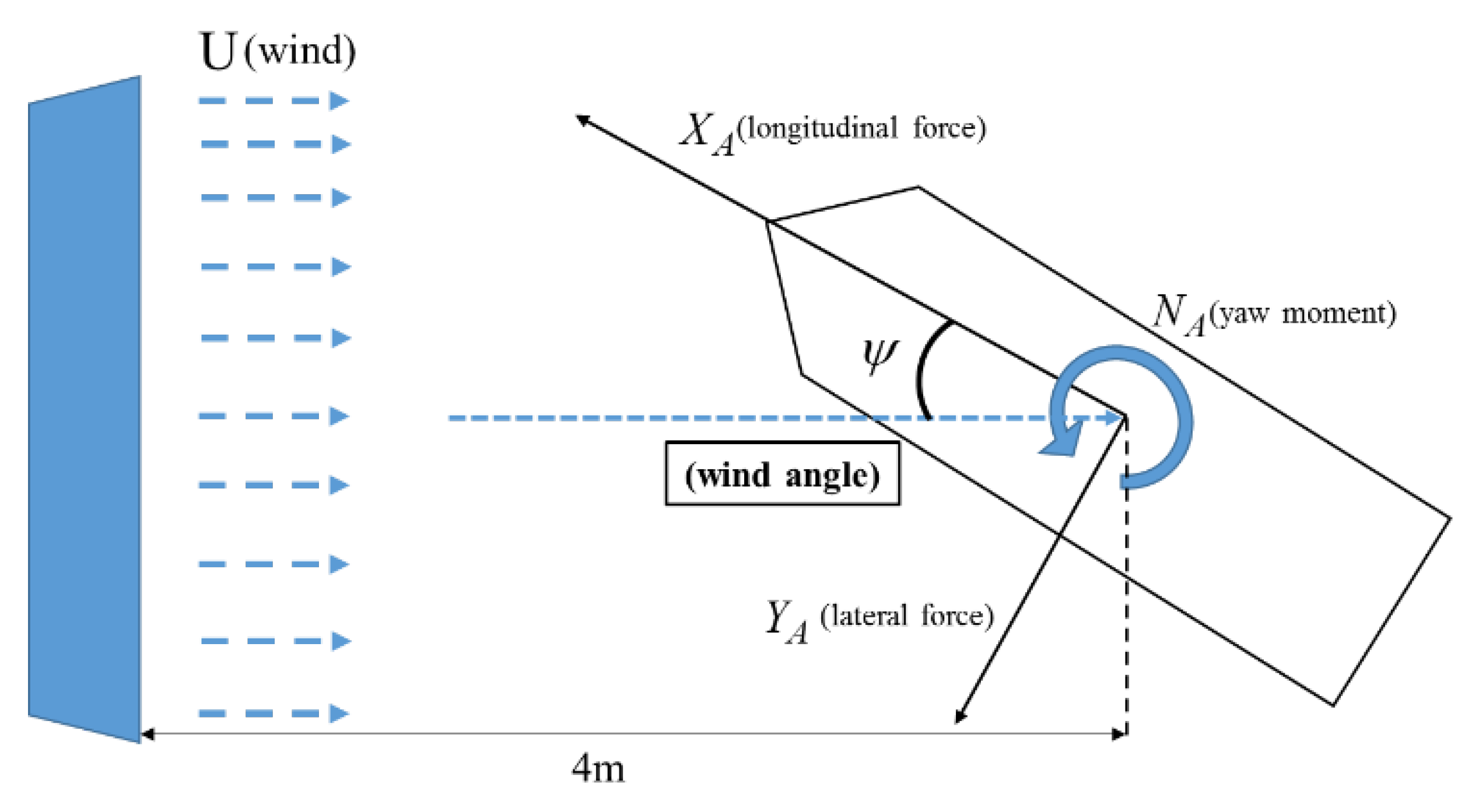
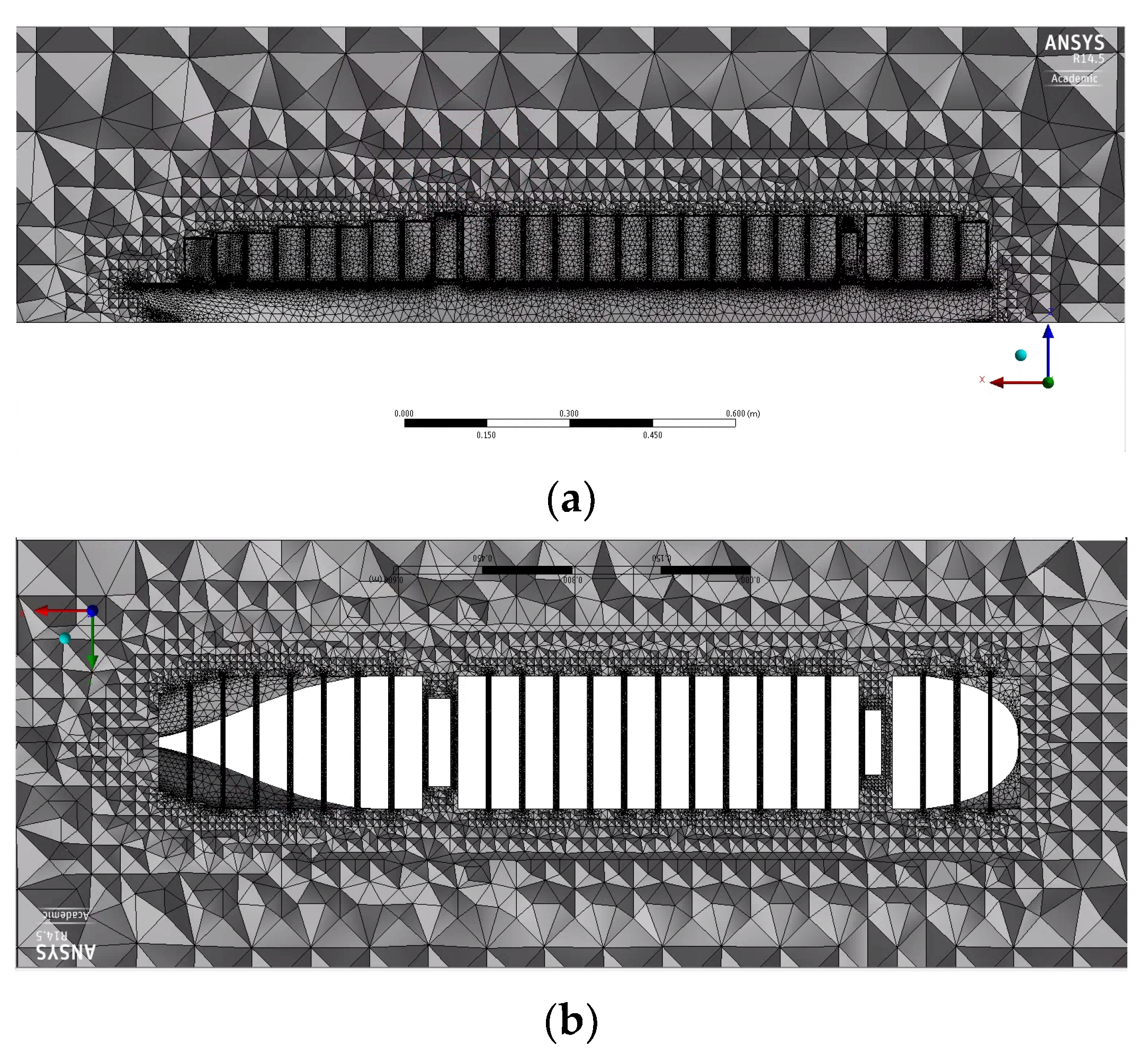
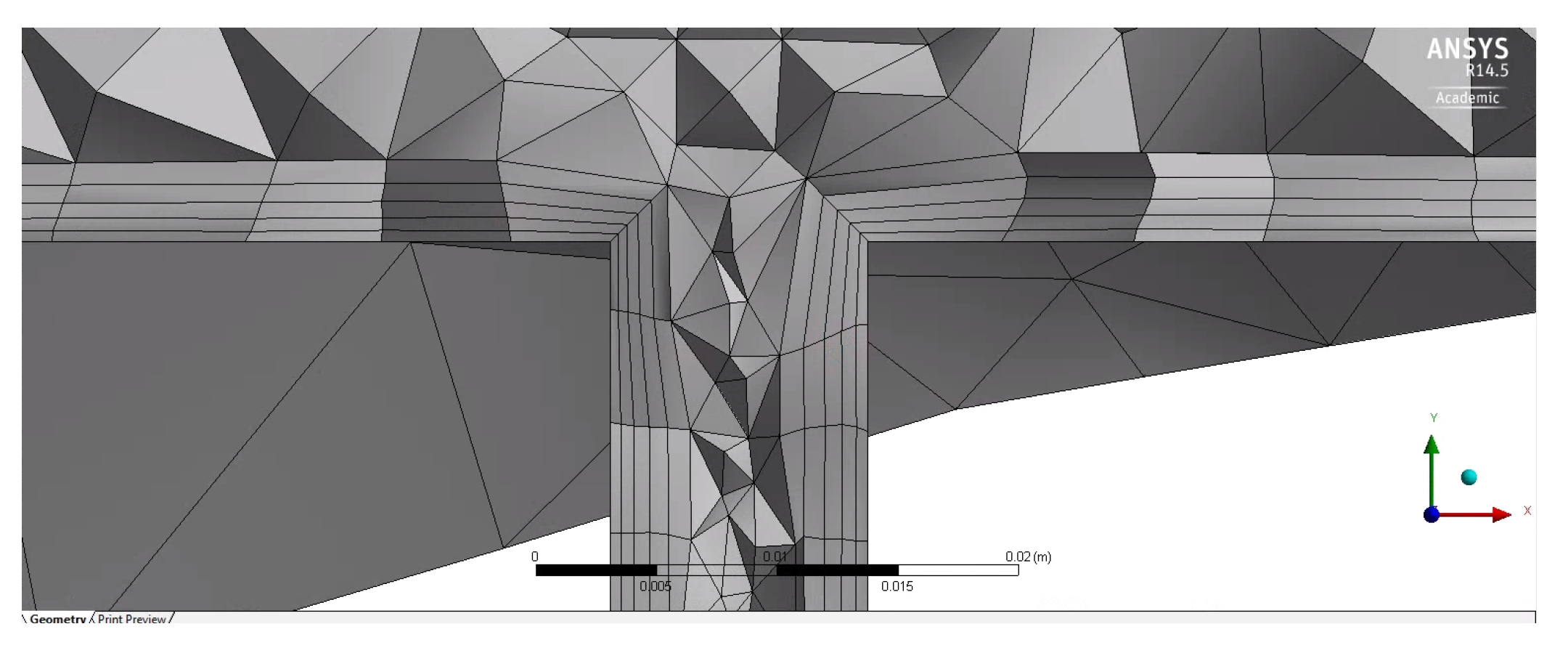
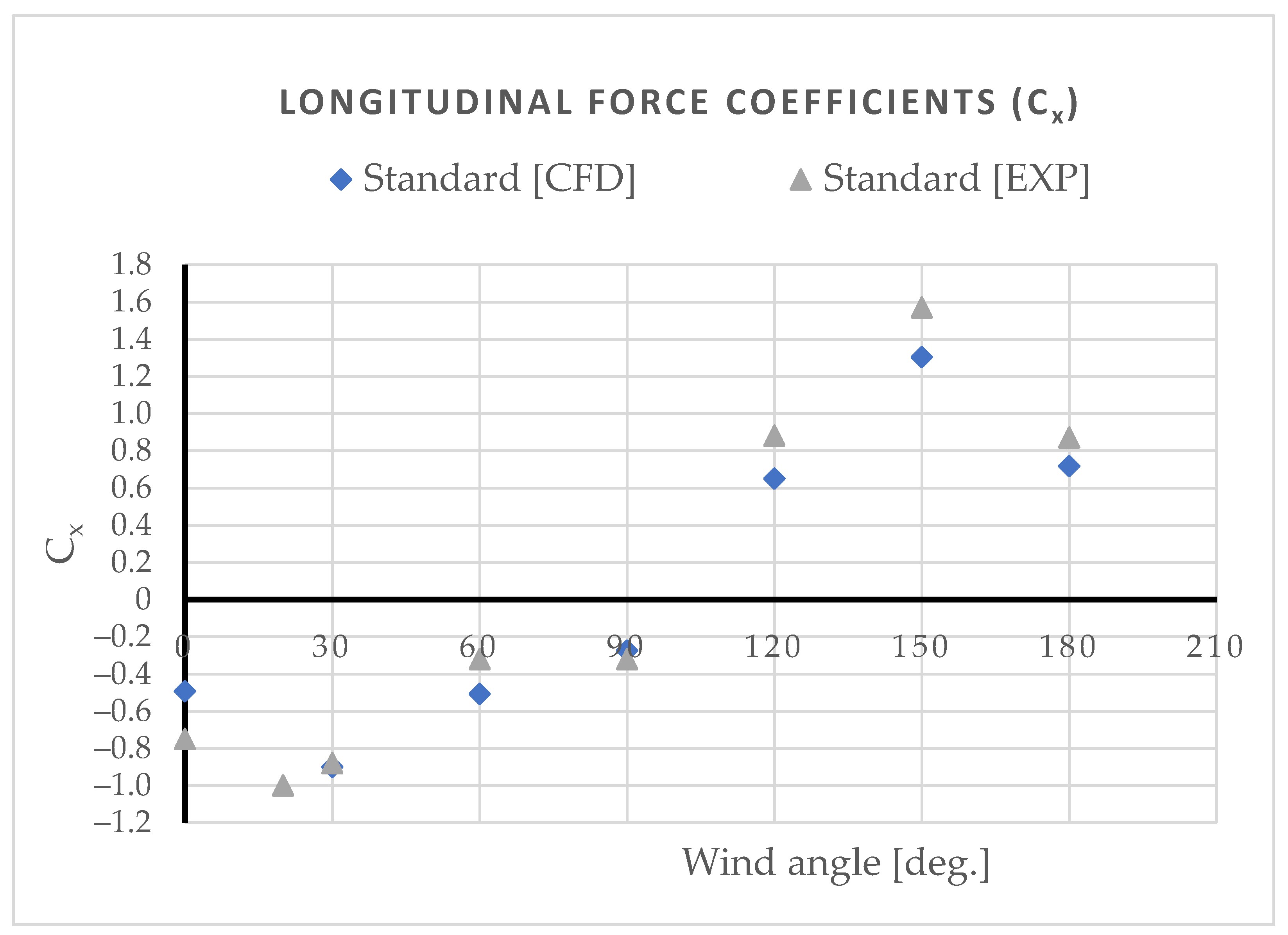

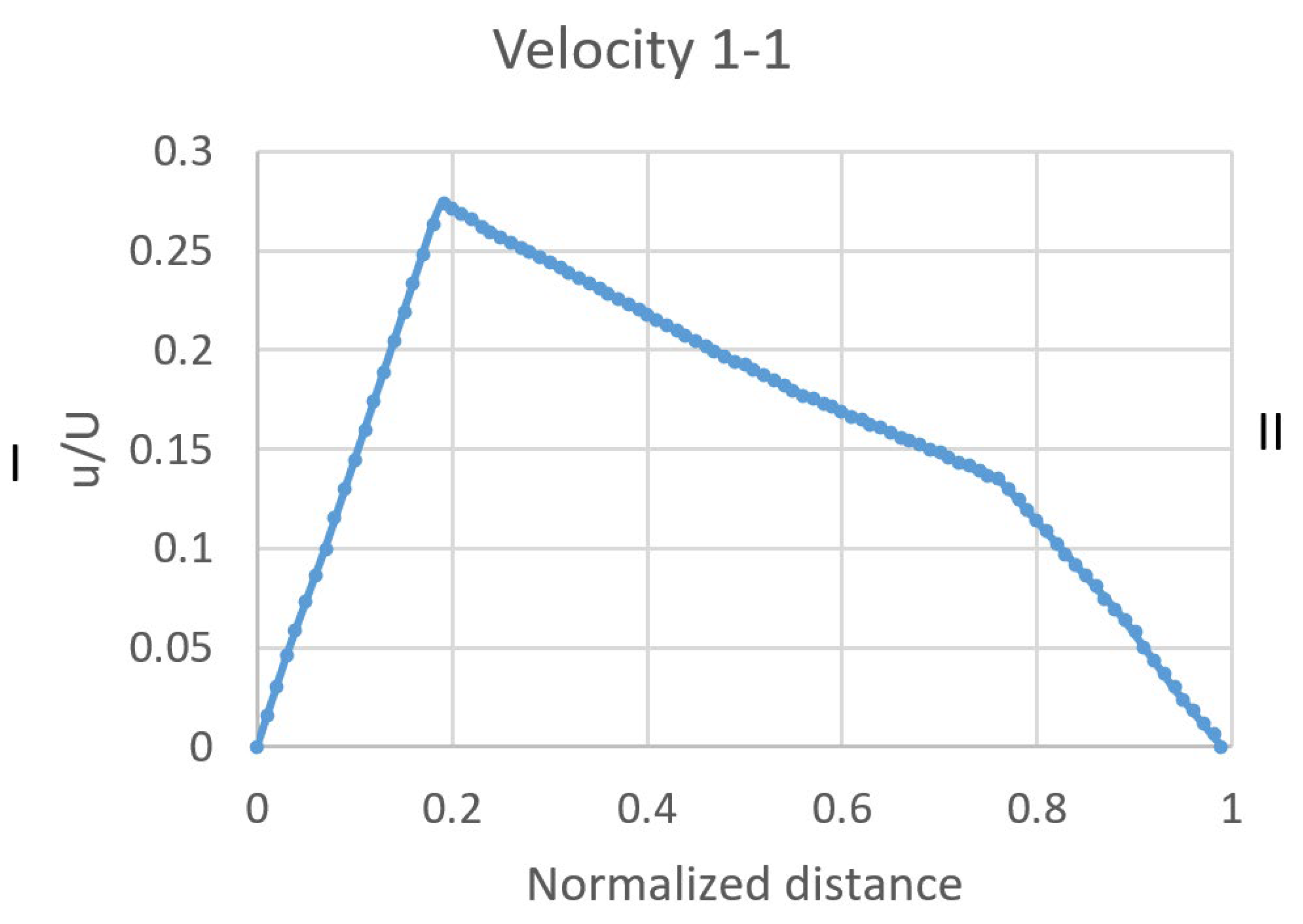

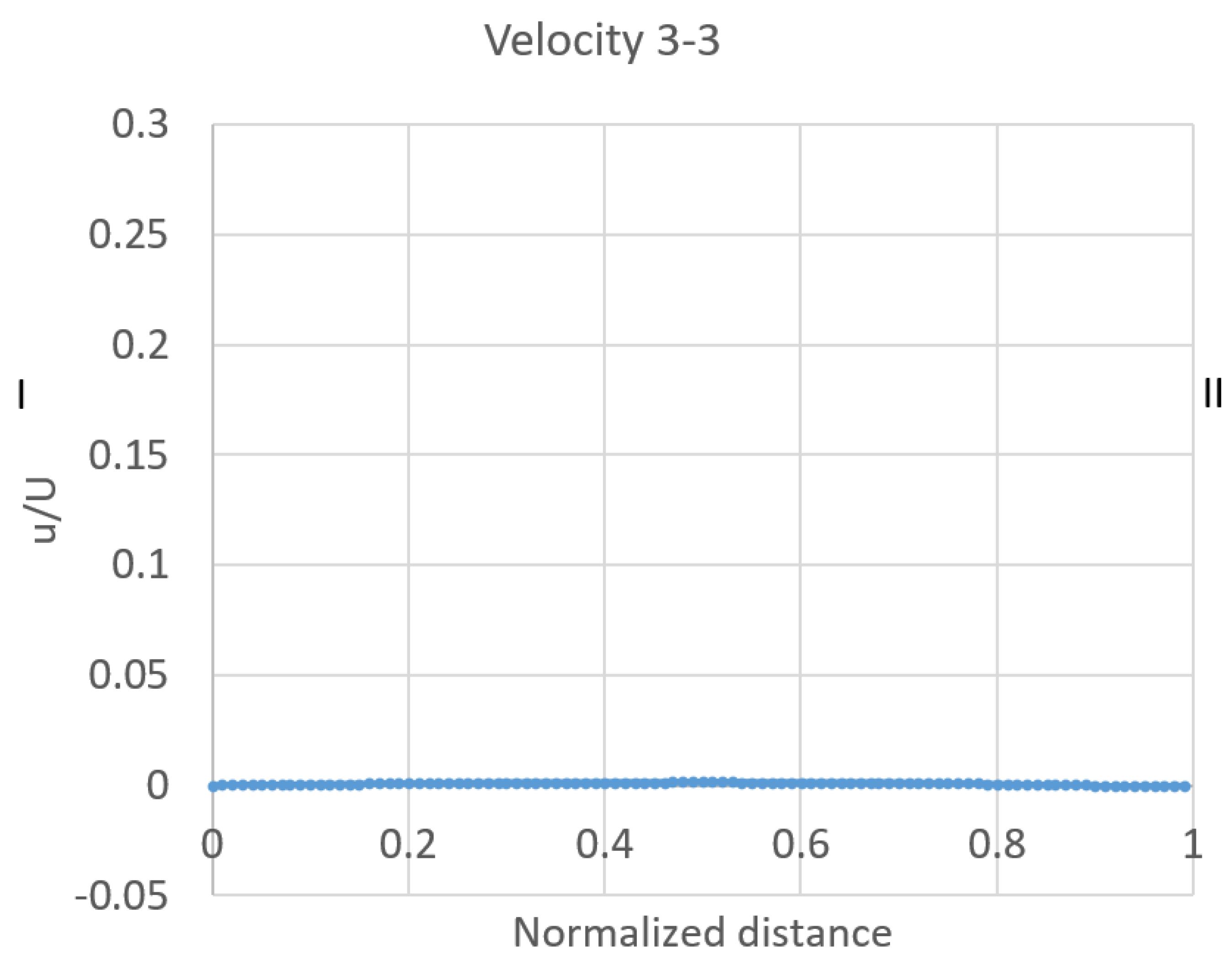

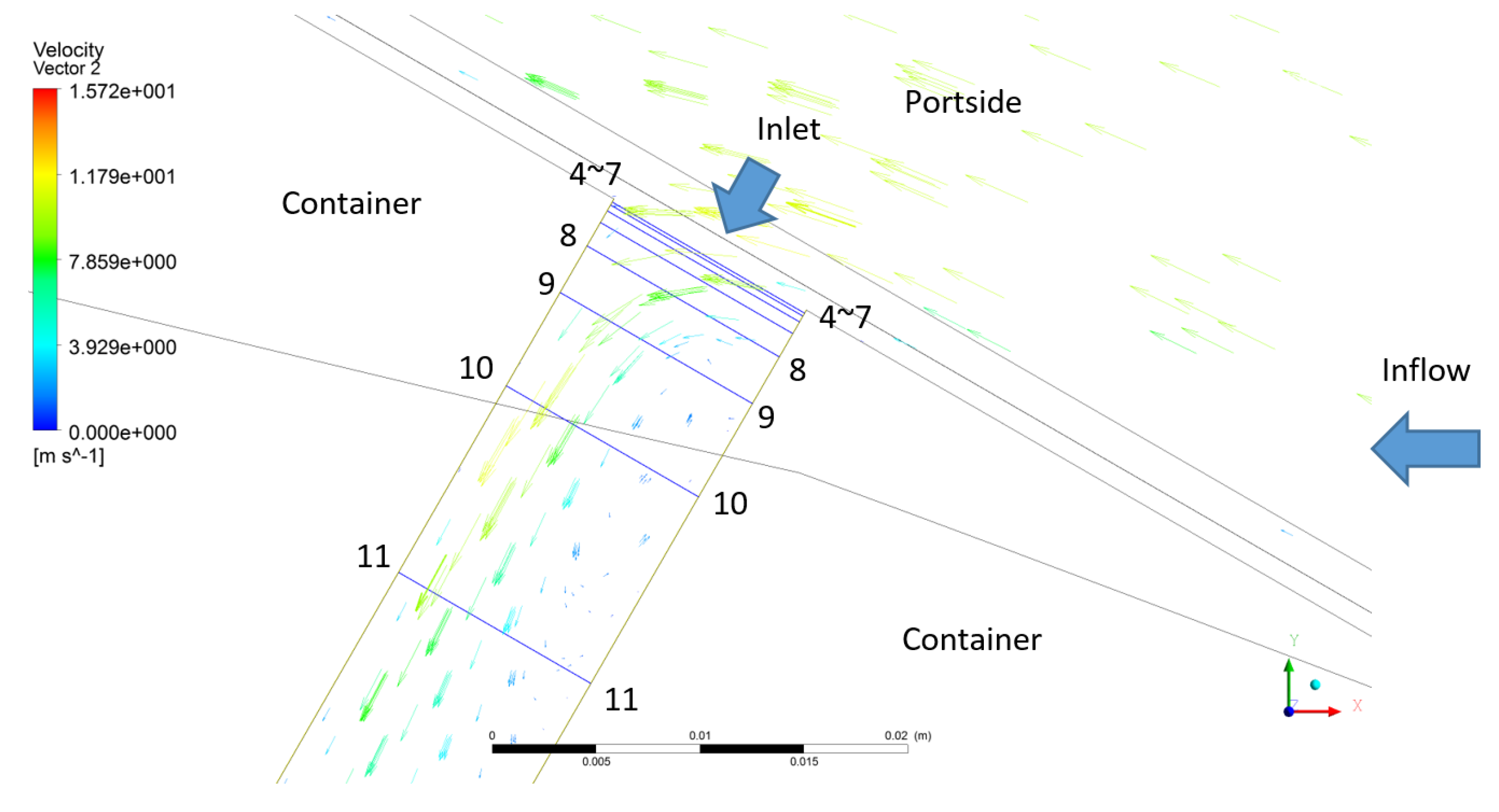
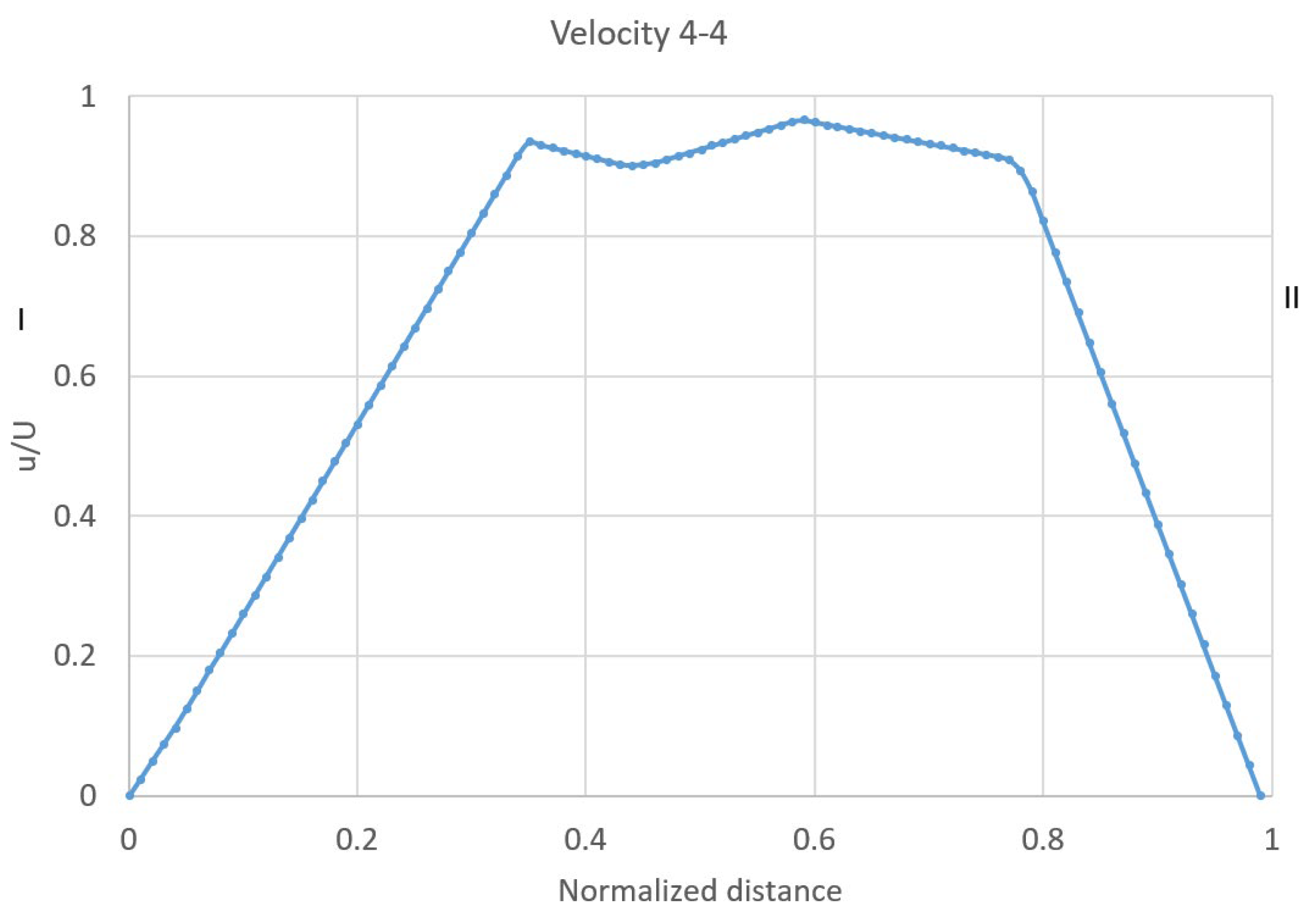
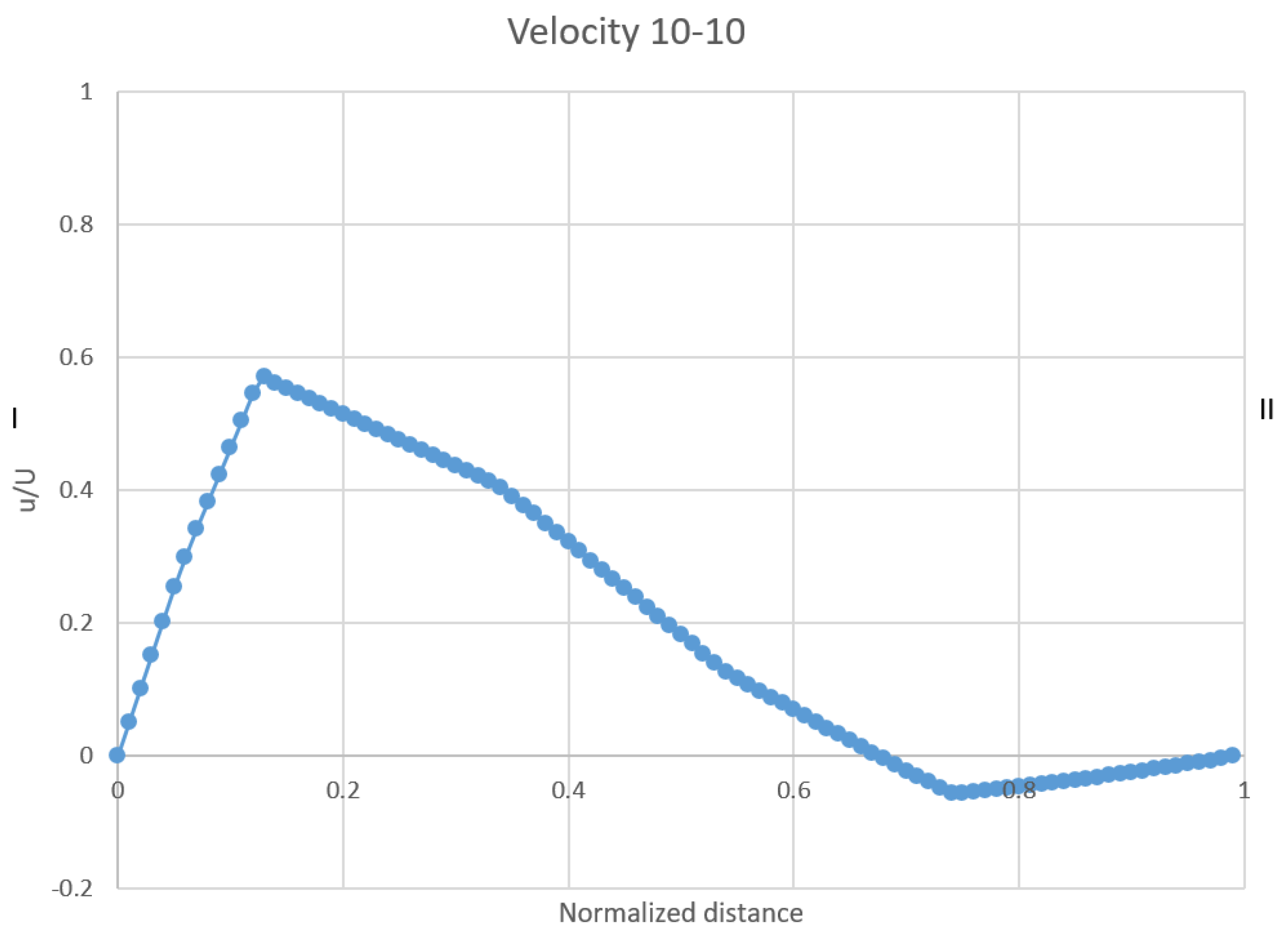
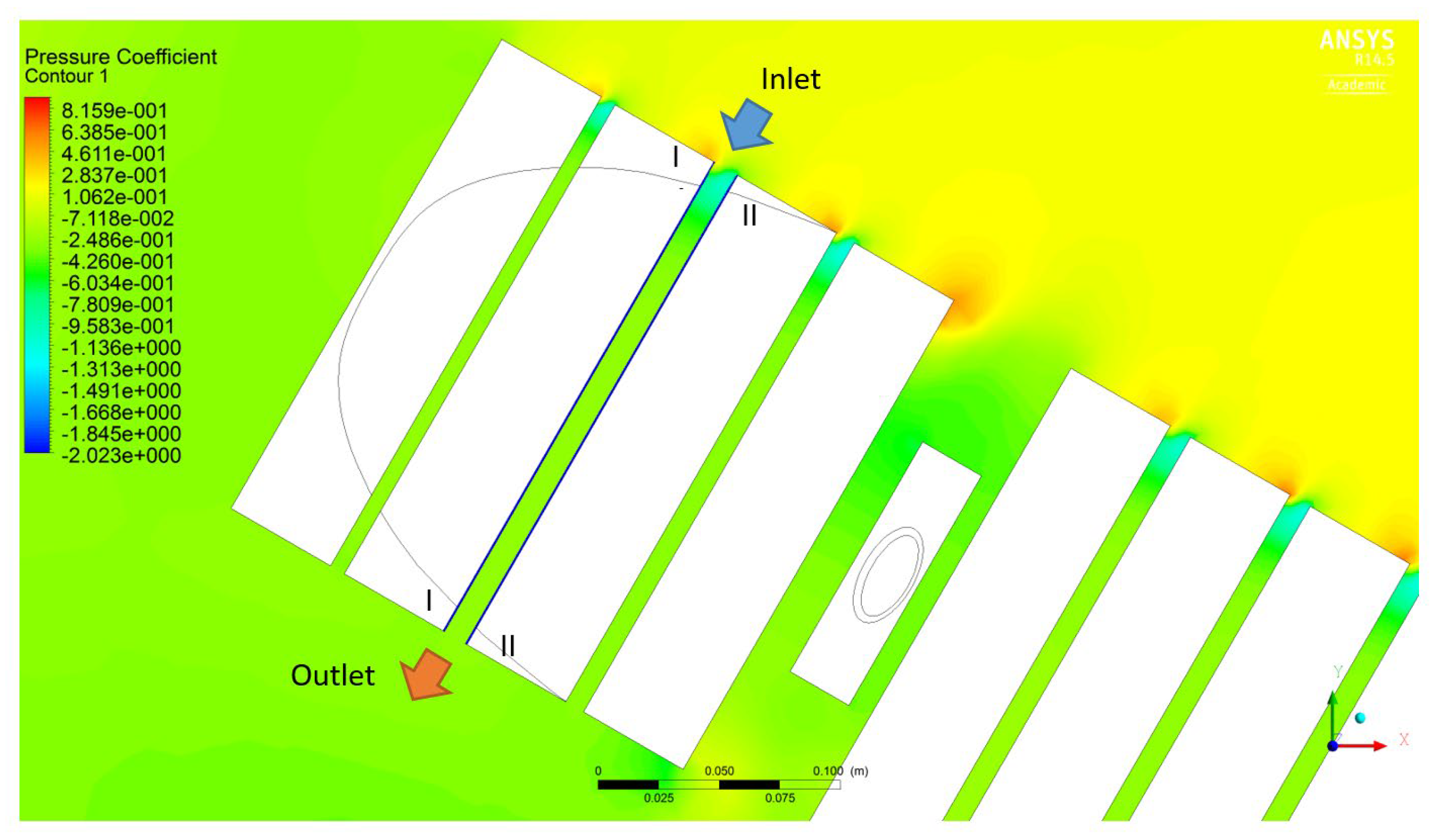

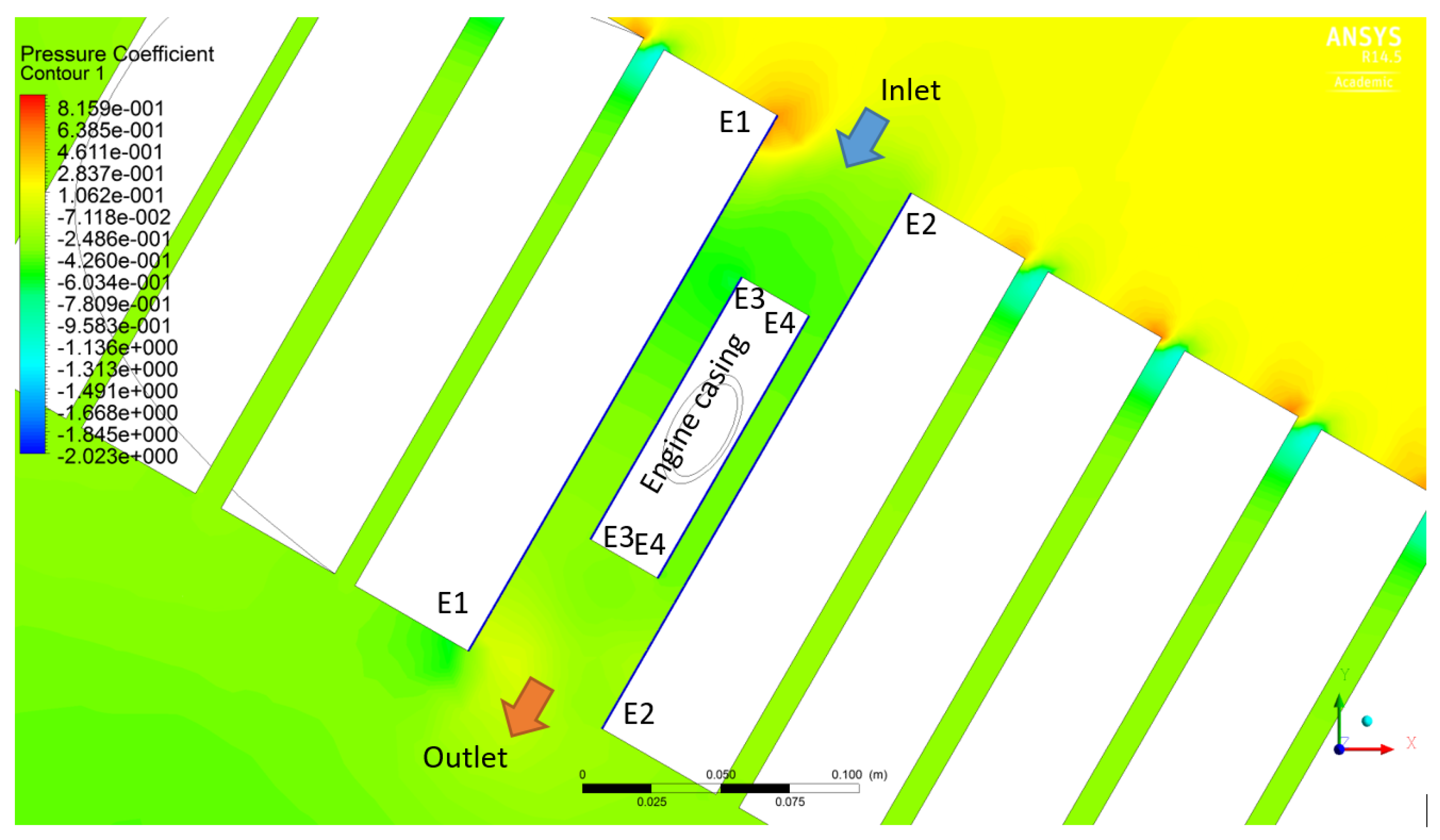
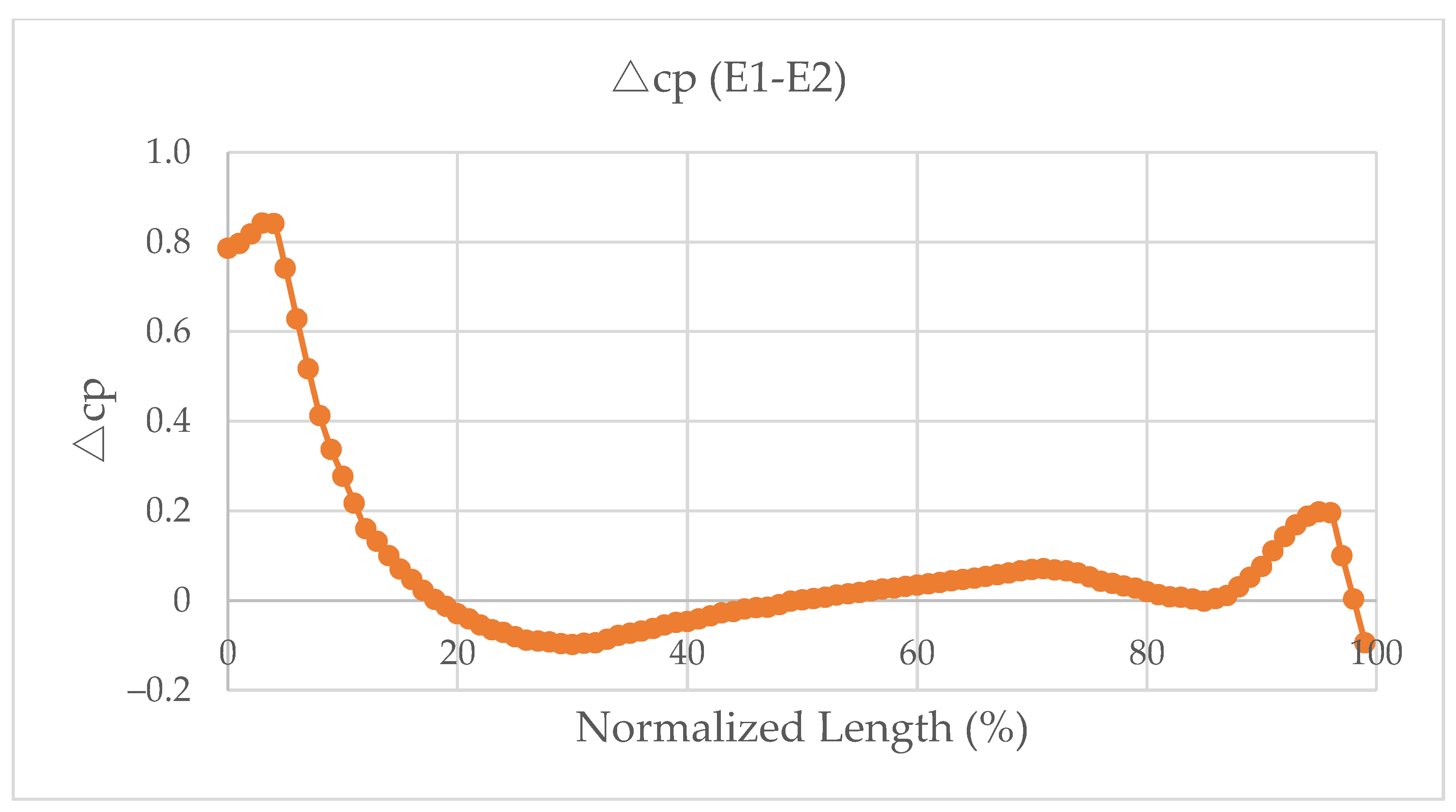
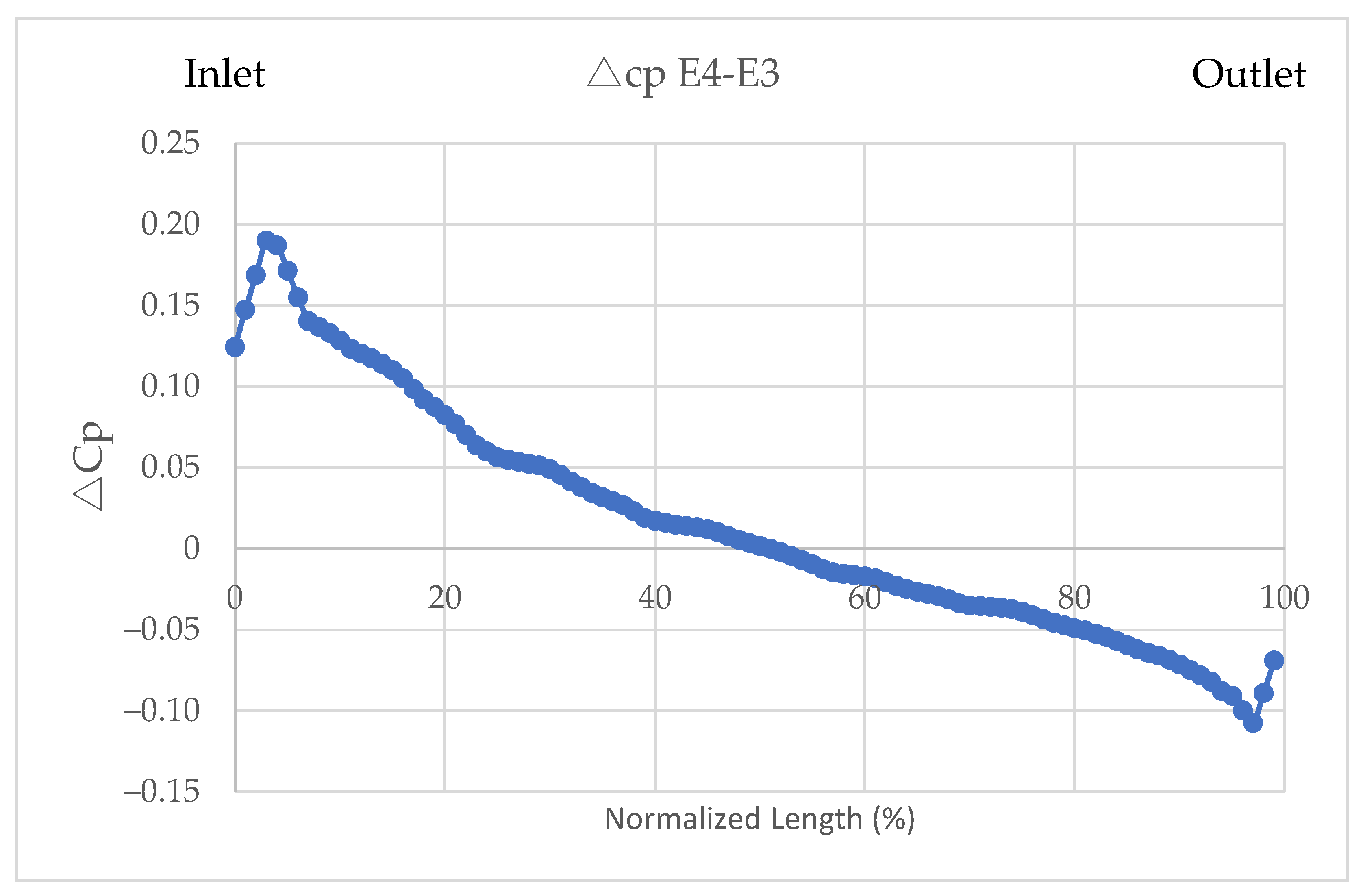
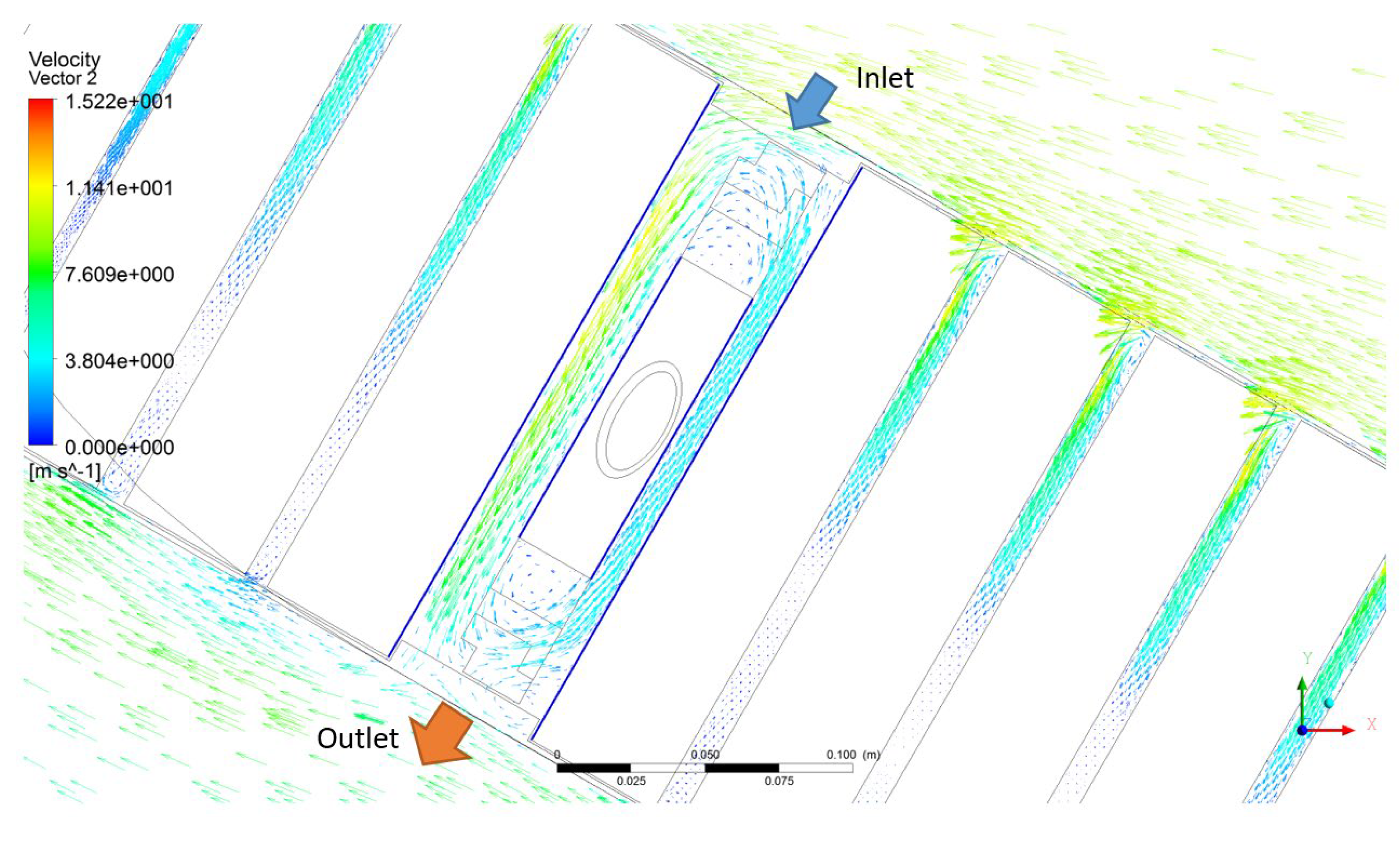
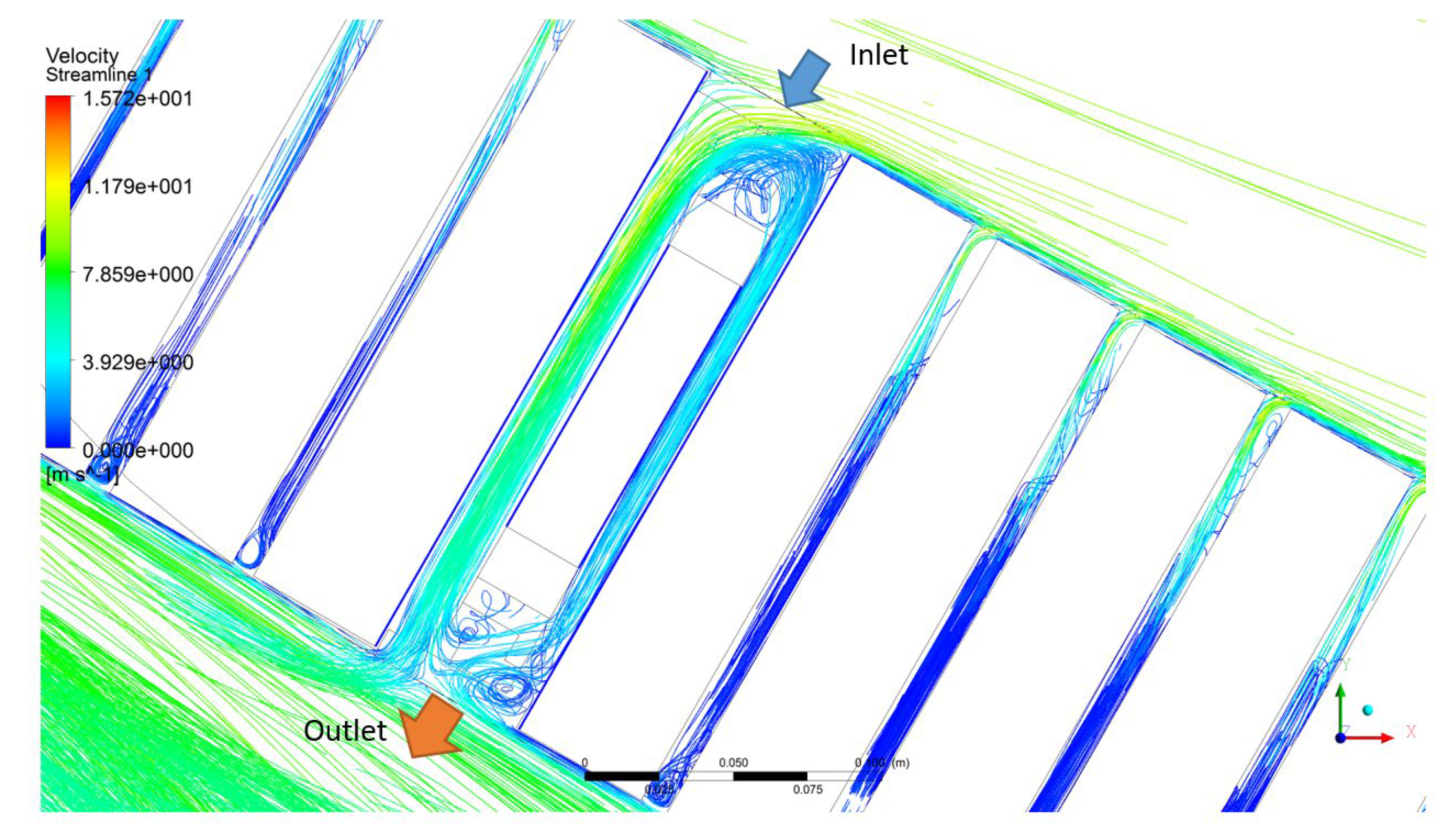
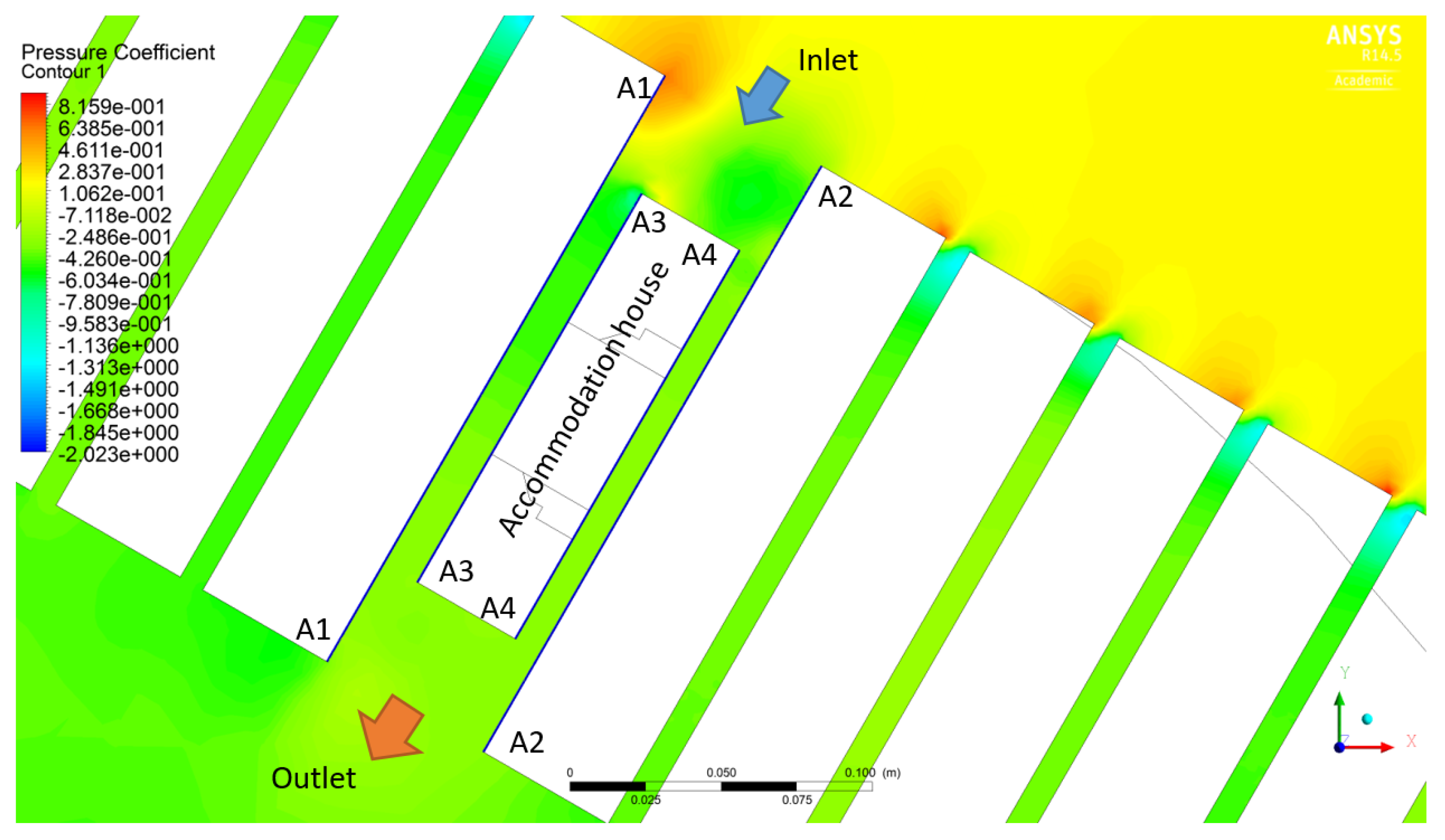
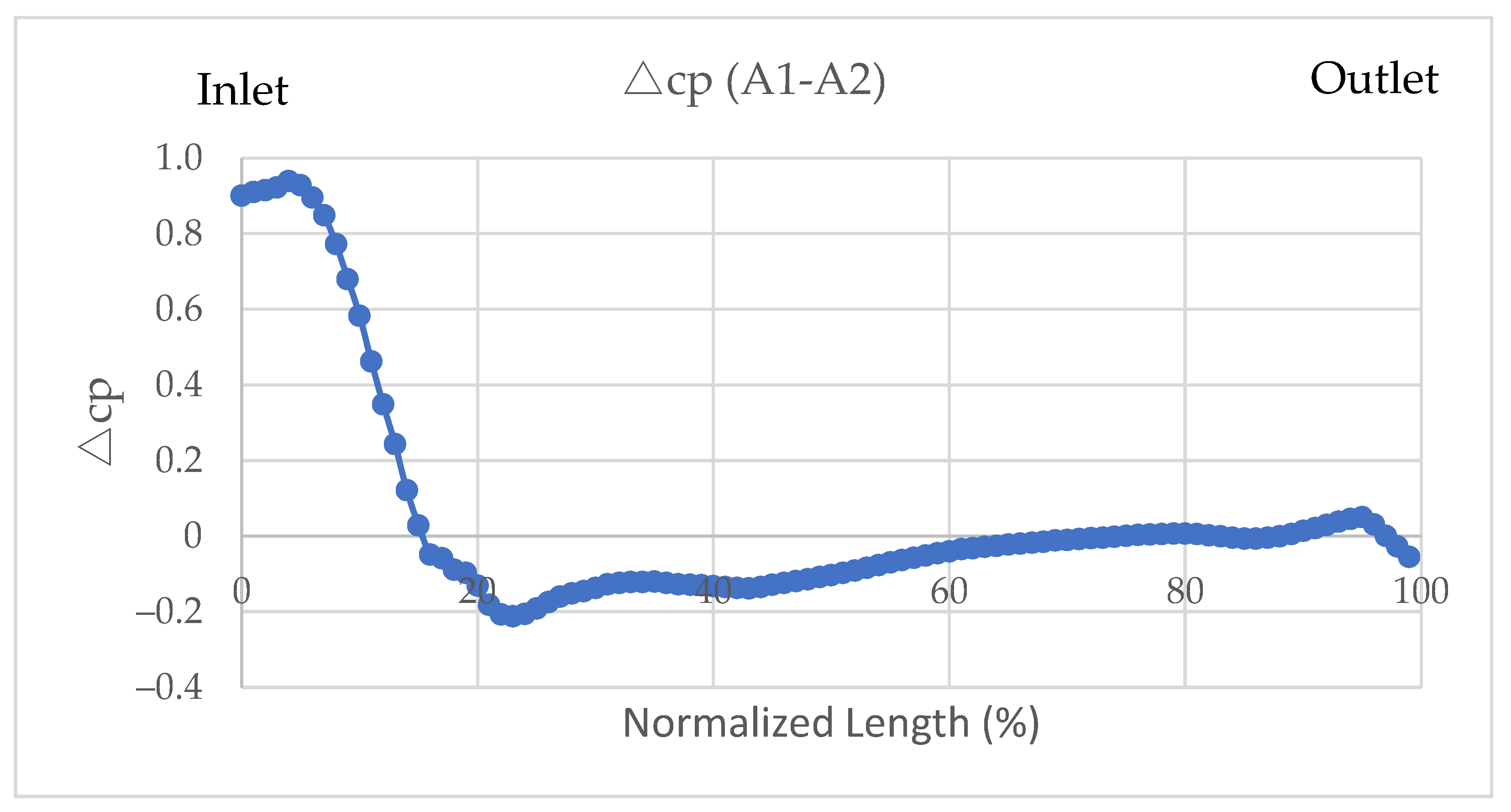

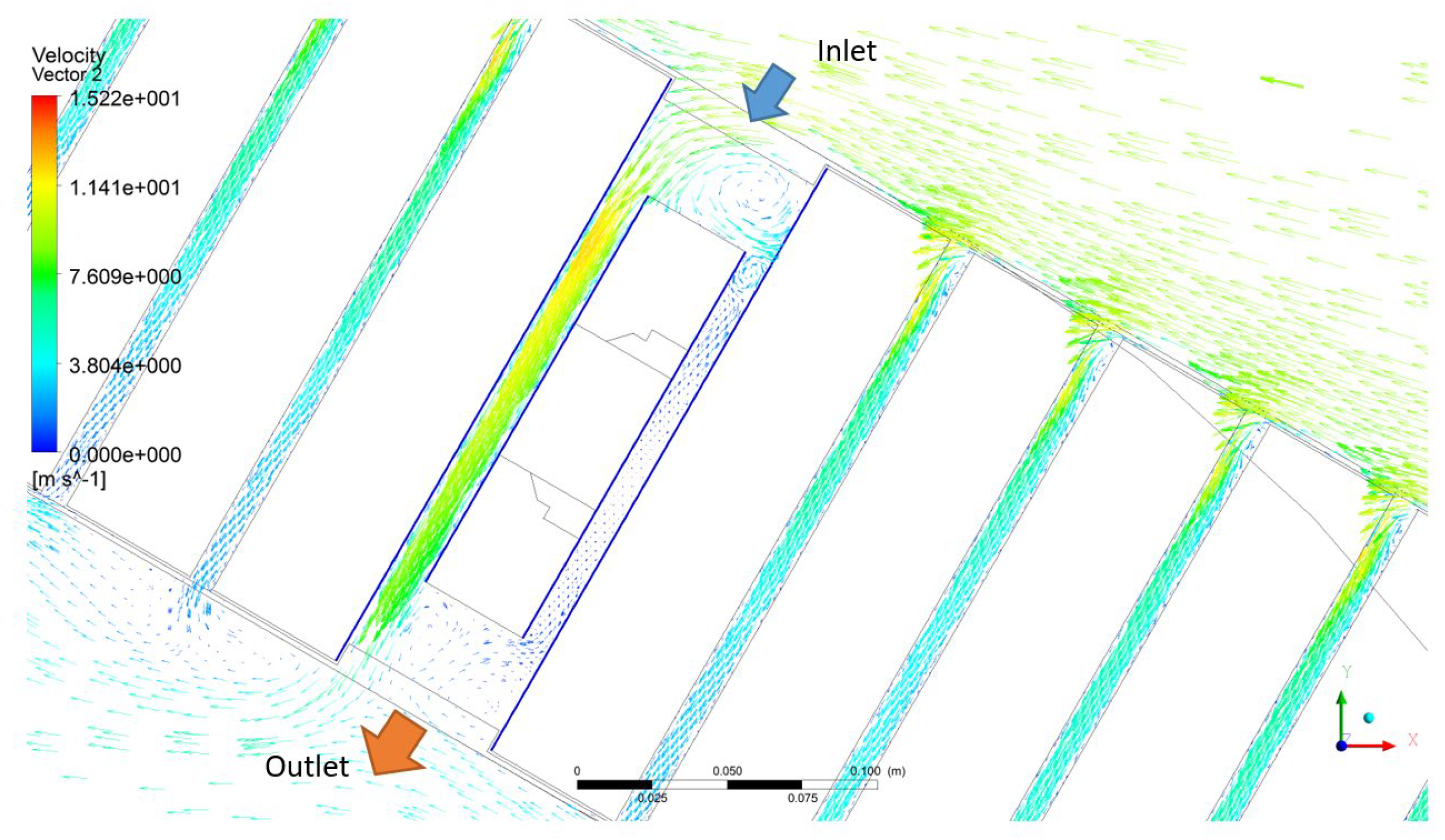
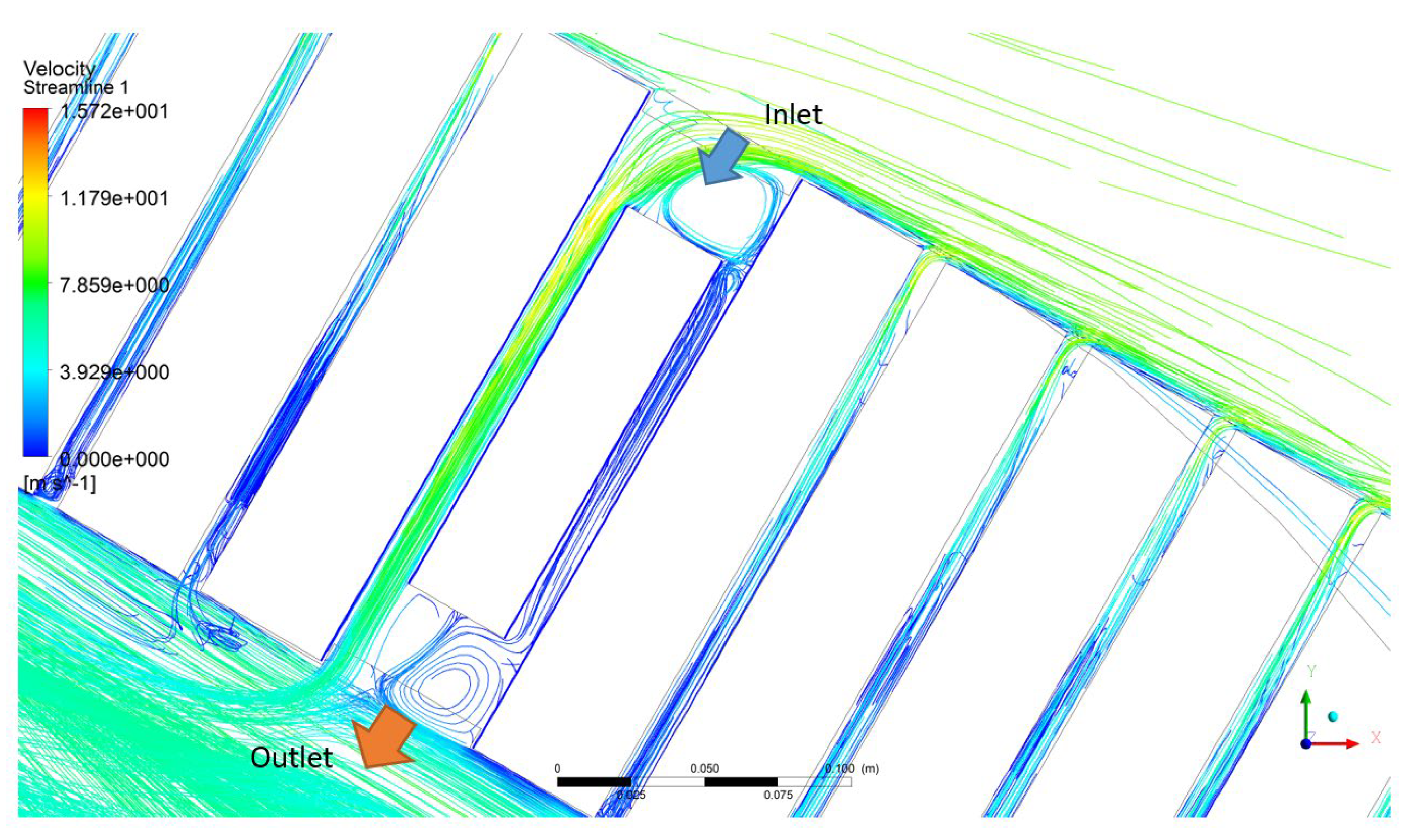
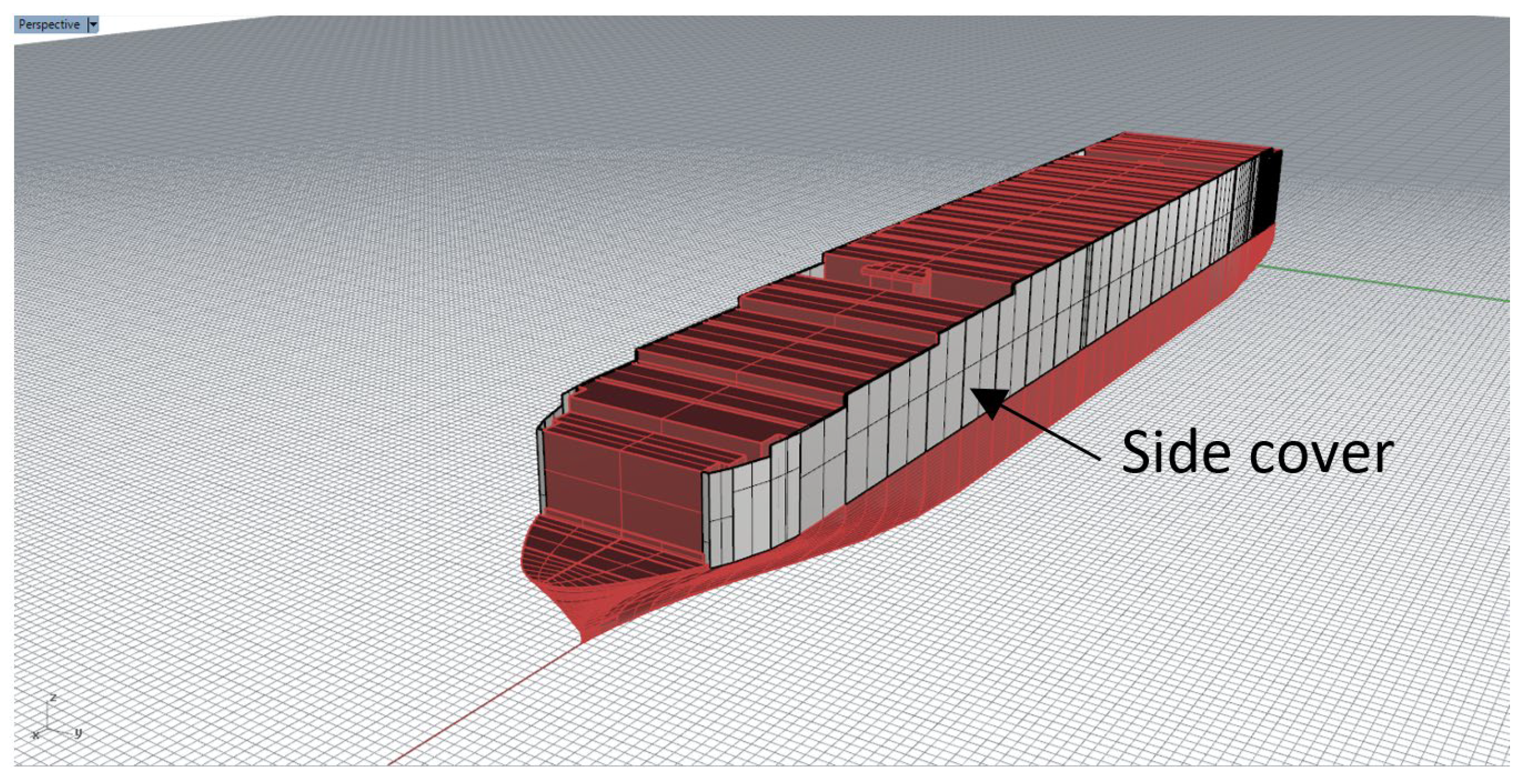
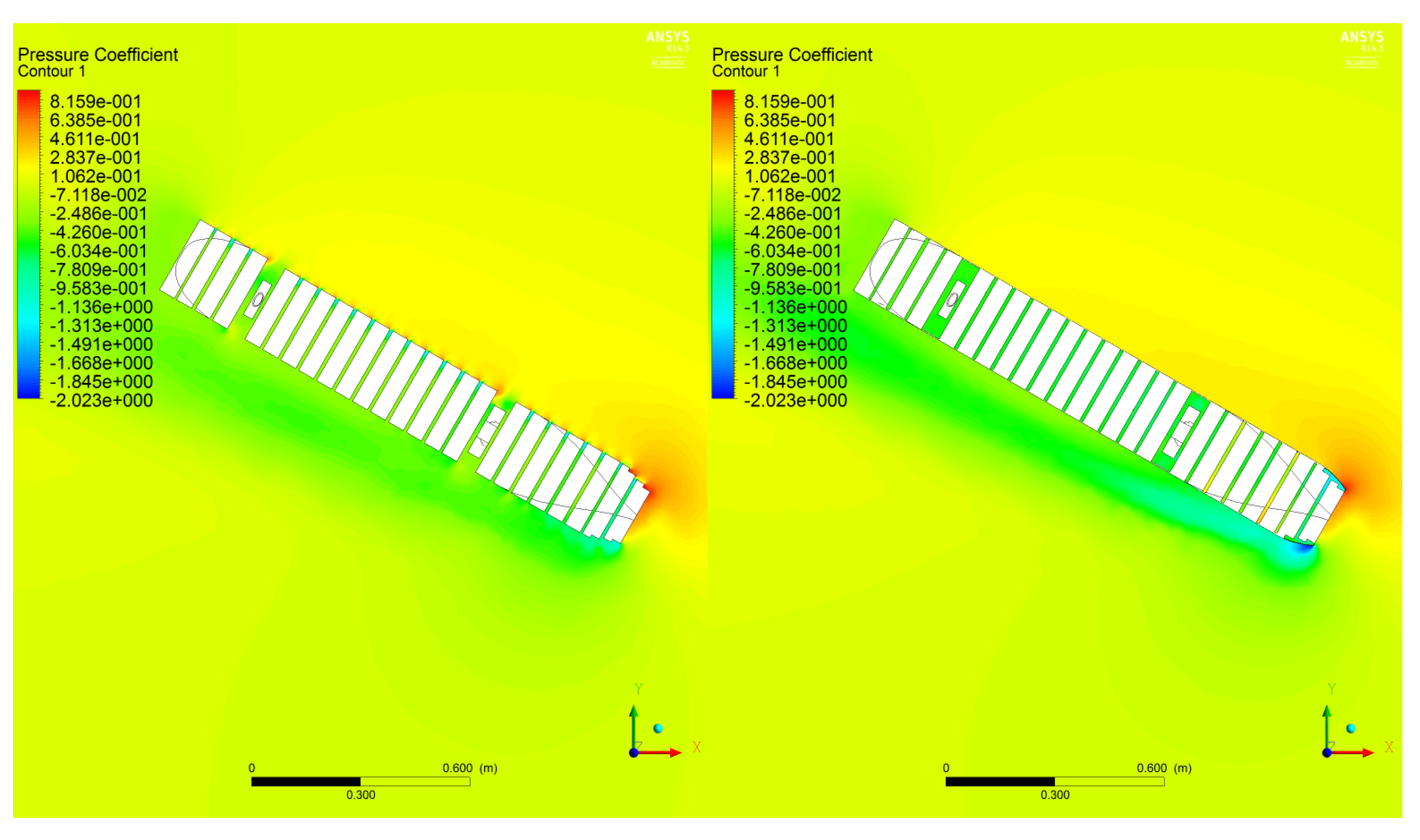

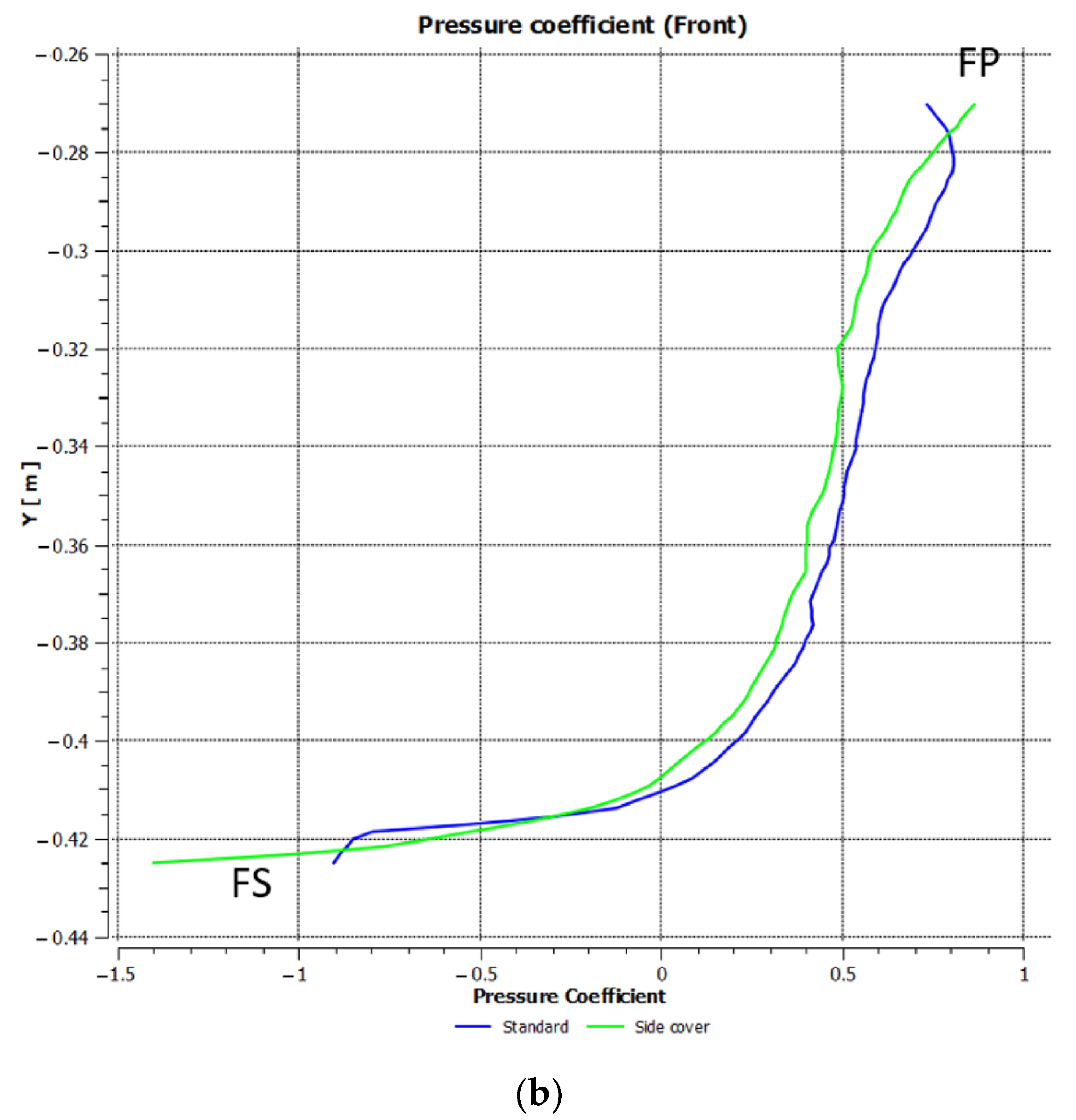
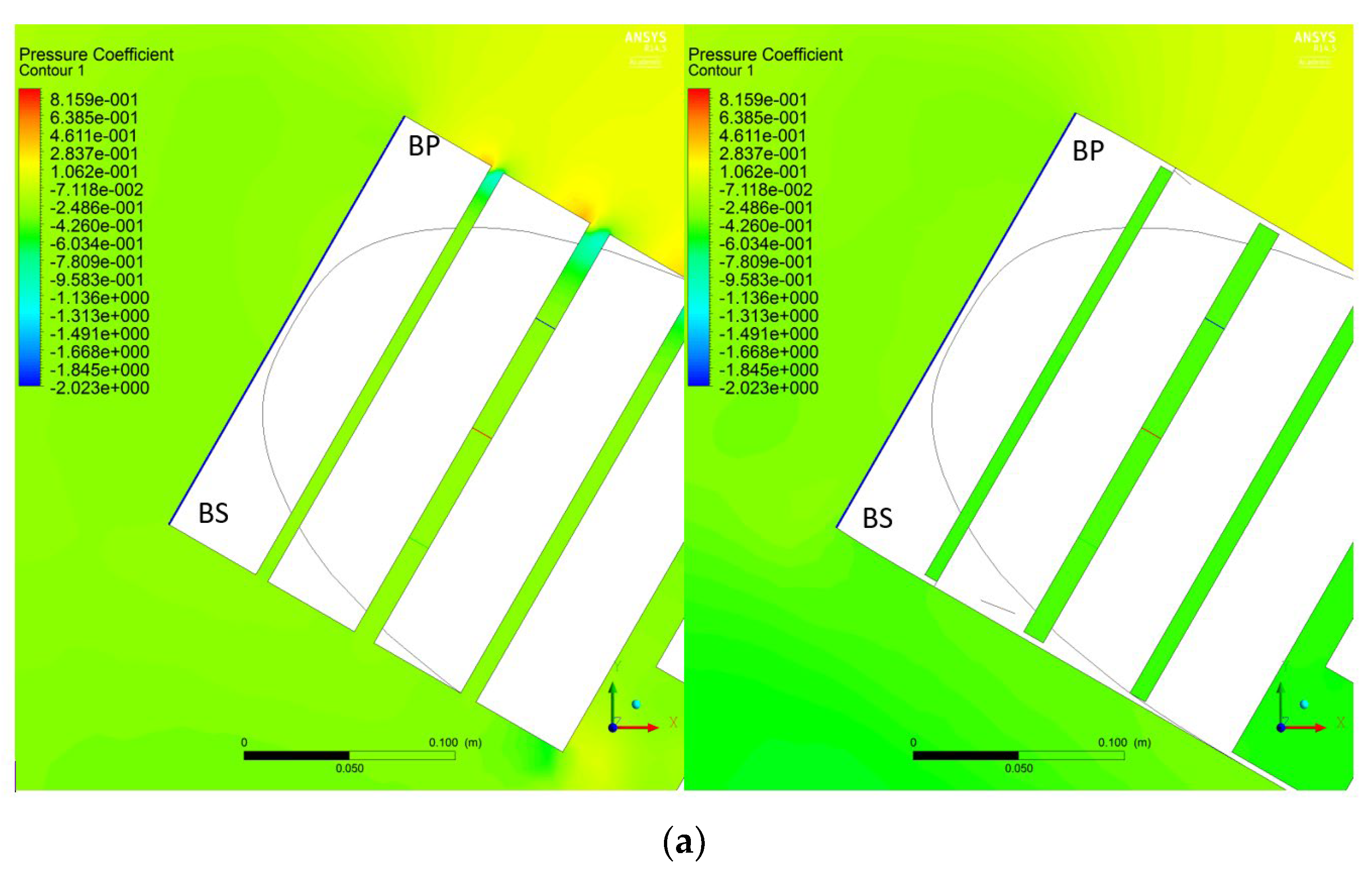



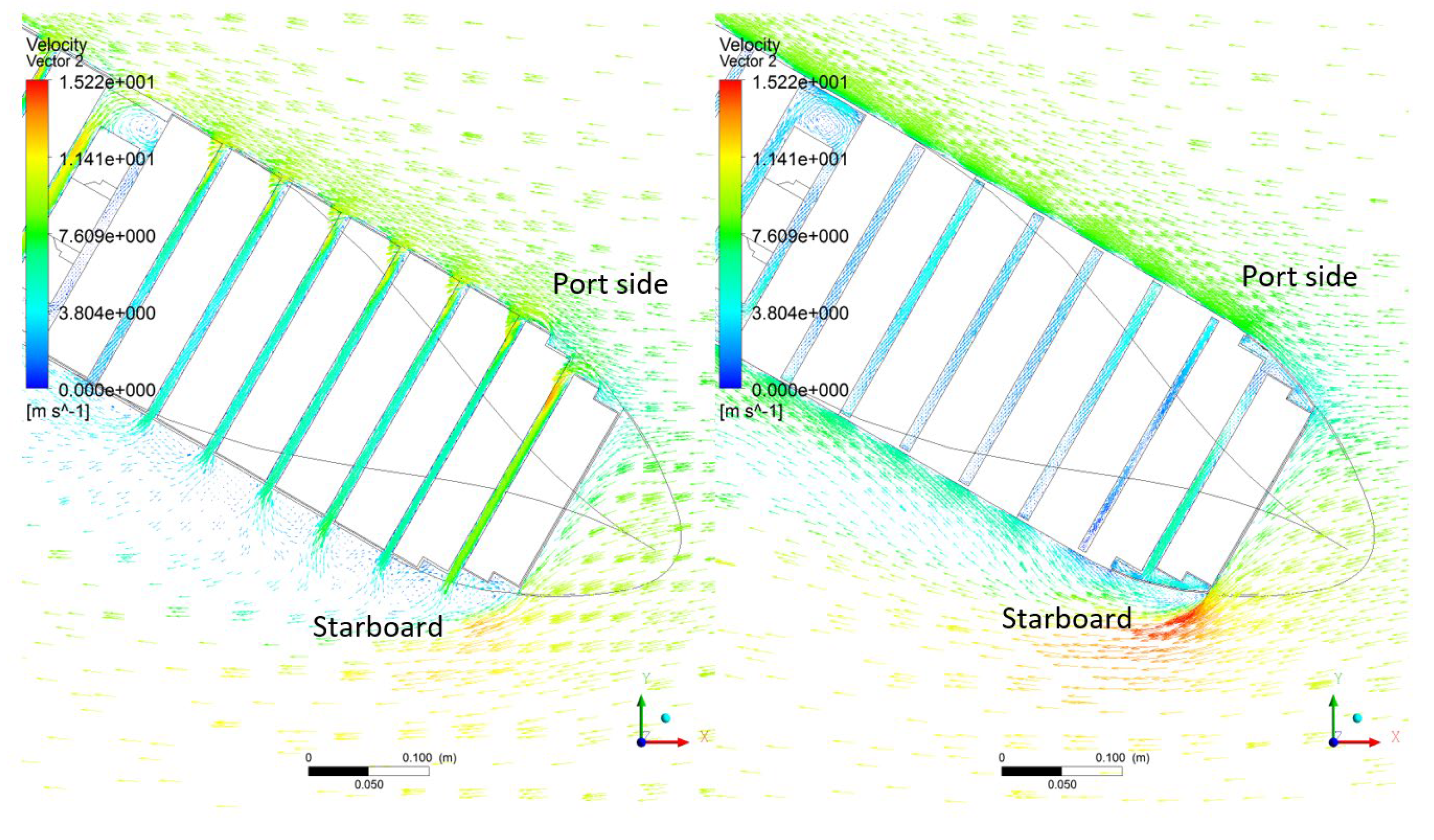

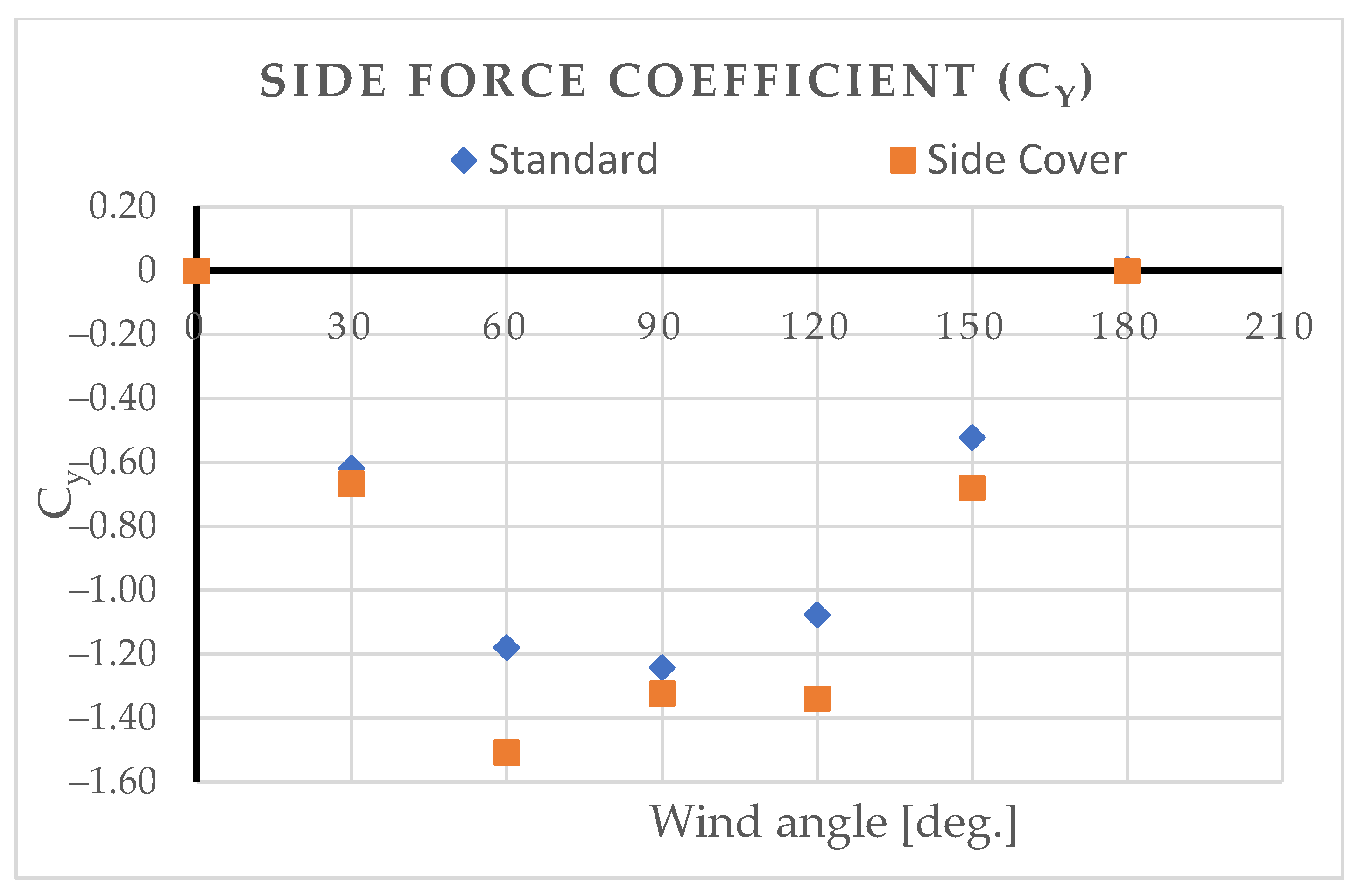
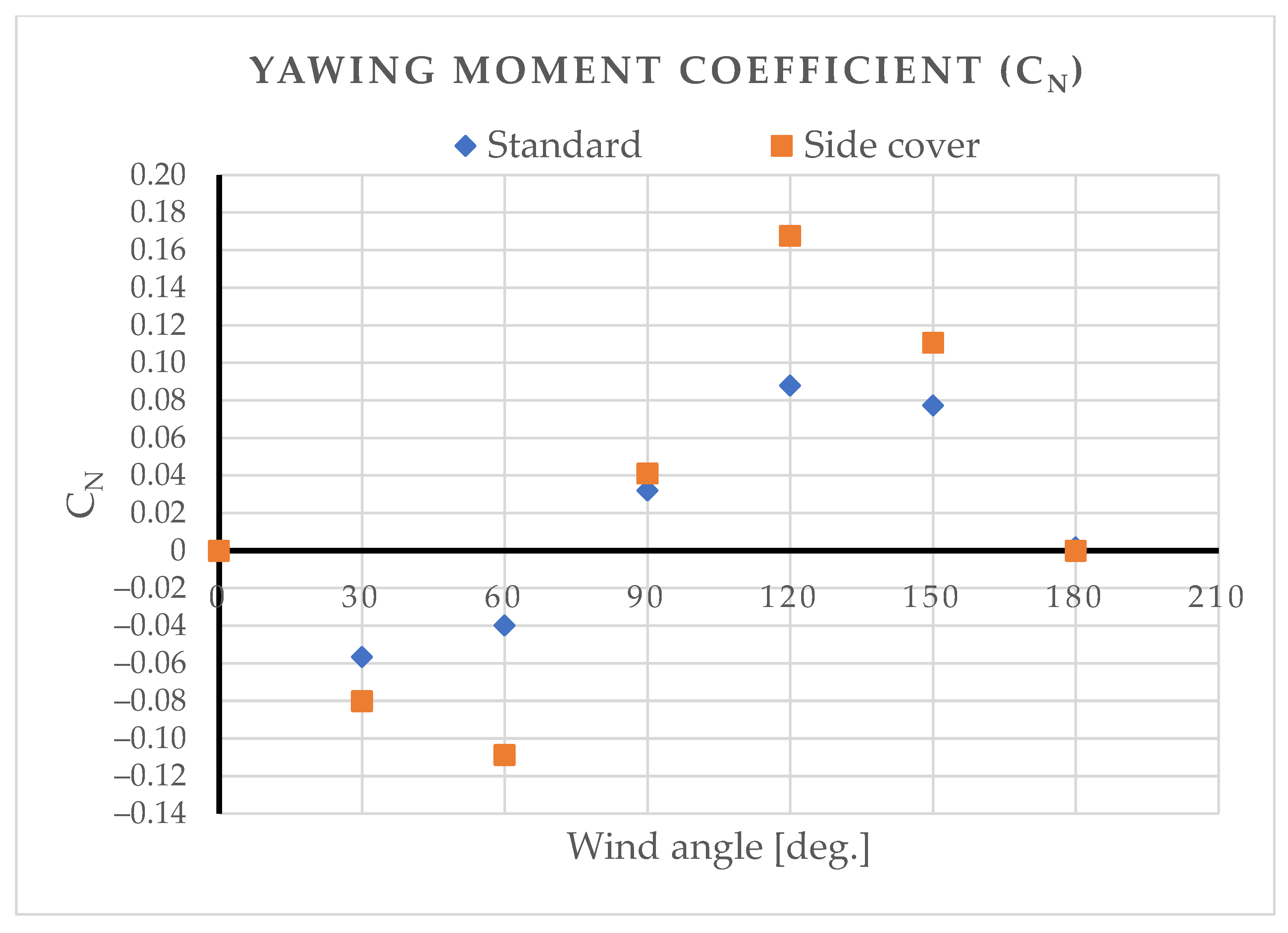
| Specifications | Unit | Ship | Model |
|---|---|---|---|
| — | 1/255.3 | ||
| Length of Overall (LOA) | [m] | 400 | 1.560 |
| Length Between Perpendicular (LPP) | [m] | 383 | 1.50 |
| Breadth (B) | [m] | 58.5 | 0.230 |
| Depth (H) | [m] | 32.06 | 0.1250 |
| Draft (d) | [m] | 14.5 | 0.0570 |
| Frontal Projected Area (AF) | [m2] | 2890 | 0.0443 |
| Side Projected Area (AS) | [m2] | 18,000 | 0.2762 |
| Solver | |
|---|---|
| Type | Pressure-Based |
| Velocity formulation | Absolute |
| Time | Steady |
| Models | |
| Viscous model | k-epsilon (2 eqs) |
| k-epsilon Model | Standard |
| Near-Wall Treatment | Standard Wall Functions |
| Materials | |
| Fluid | Air |
| Properties | |
| Density | 1.225 (kg/m3) |
| Viscosity | 1.7894 × 10−5 |
| Boundary Conditions | |
| Inlet | Velocity inlet: Velocity Magnitude: 10 (m/s) Turbulent Intensity: 5% Turbulent Viscosity Ratio: 10 |
| Outlet | Pressure outlet: Backflow Turbulent Intensity: 5% Backflow Turbulent Viscosity Ratio: 10 |
| Ship | Wall: No Slip |
| Top, bottom, sidewalls | Wall: Slip |
| Solution Methods | |
| Pressure-Velocity Coupling | |
| Scheme | SIMPLE |
| Spatial Discretization | |
| Gradient | Least Squares Cell-Based |
| Pressure | Standard |
| Momentum | Second-Order Upwind |
| Turbulent Kinetic Energy | Second-Order Upwind |
| Turbulent Dissipation Rate | Second-Order Upwind |
| Model | Cx | ΔCx (%) (*) |
|---|---|---|
| Standard | −0.90118 | |
| Side cover | −0.42042 | −53.35 |
Disclaimer/Publisher’s Note: The statements, opinions and data contained in all publications are solely those of the individual author(s) and contributor(s) and not of MDPI and/or the editor(s). MDPI and/or the editor(s) disclaim responsibility for any injury to people or property resulting from any ideas, methods, instructions or products referred to in the content. |
© 2023 by the authors. Licensee MDPI, Basel, Switzerland. This article is an open access article distributed under the terms and conditions of the Creative Commons Attribution (CC BY) license (https://creativecommons.org/licenses/by/4.0/).
Share and Cite
Nguyen, V.T.; Le, M.D.; Nguyen, V.M.; Katayama, T.; Ikeda, Y. Influences of Gap Flow on Air Resistance Acting on a Large Container Ship. J. Mar. Sci. Eng. 2023, 11, 160. https://doi.org/10.3390/jmse11010160
Nguyen VT, Le MD, Nguyen VM, Katayama T, Ikeda Y. Influences of Gap Flow on Air Resistance Acting on a Large Container Ship. Journal of Marine Science and Engineering. 2023; 11(1):160. https://doi.org/10.3390/jmse11010160
Chicago/Turabian StyleNguyen, Van Trieu, Minh Duc Le, Van Minh Nguyen, Toru Katayama, and Yoshiho Ikeda. 2023. "Influences of Gap Flow on Air Resistance Acting on a Large Container Ship" Journal of Marine Science and Engineering 11, no. 1: 160. https://doi.org/10.3390/jmse11010160
APA StyleNguyen, V. T., Le, M. D., Nguyen, V. M., Katayama, T., & Ikeda, Y. (2023). Influences of Gap Flow on Air Resistance Acting on a Large Container Ship. Journal of Marine Science and Engineering, 11(1), 160. https://doi.org/10.3390/jmse11010160






